The Masai Mara National Reserve
The Masai Mara is synonymous with wildlife, safaris, and an event that has come to be called the 'great migration'. Mention Africa, and a picture of game from here springs to mind right away: zebras and giraffes, wildebeest and hippopotami, lions and cheetahs, amidst the tall grasses of the savannahs and murky pools of the waterholes. The Masai Mara National Reserve is the best known of Kenya's parks and reserves, and along with the Serengeti, epitomizes Africa and the word 'safari'.
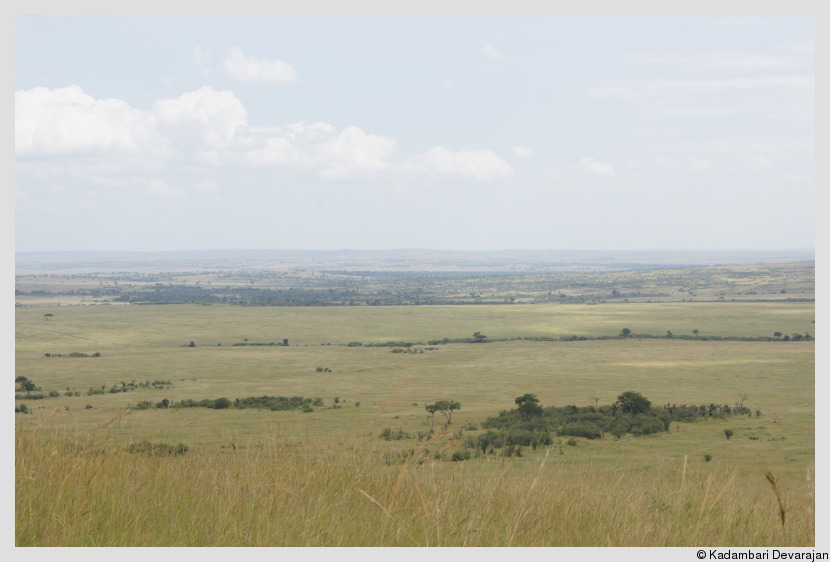
The Masai Mara plains
Contiguous with the Serengeti National Park in Tanzania, the Mara is a large game reserve in Narok County in south-western Kenya, just below the equator. It is named in honor of the ancestral inhabitants of the area, the Masai people, and their description of the landscape when seen from afar, Mara. In the Masai language, "mara" means "spotted"; the plains do indeed seem dotted with trees, shrubs, herds of animals, and shadows from the clouds, along the savanna.
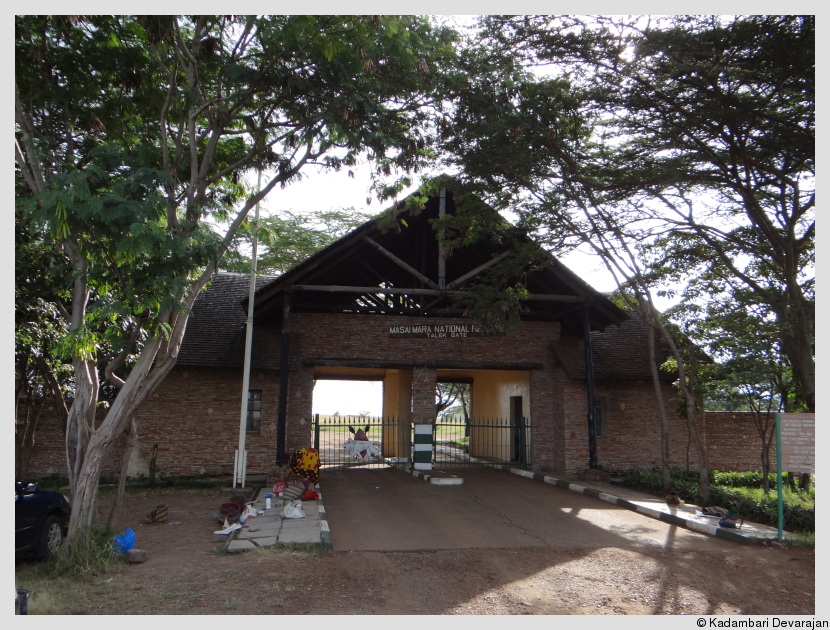
Entry to the park from the Talek side
The Masai Mara National Reserve forms only a small fraction of what is known as the Greater Mara ecosystem, which includes the Mara Triangle as well as a number of ranches. It is primarily composed of open grasslands called savannas, with some scrub and riverine forests thrown in.
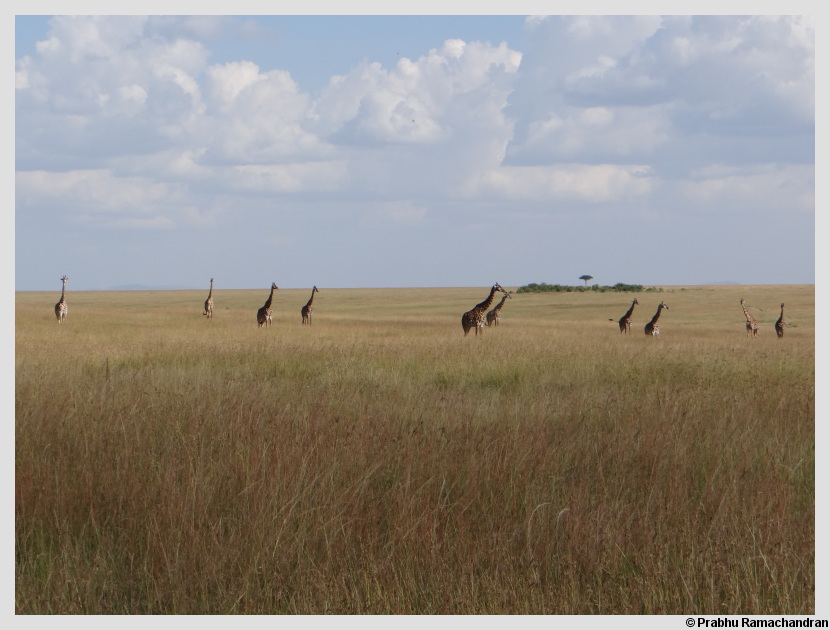
Masai giraffes ambling along the Mara plains
There are seasonal rivulets and patches of characteristic acacia trees across the plains. It falls in the equatorial belt, and is bordered on the west by the East African Rift, which makes this area marshy leading to greater concentrations of wildlife due to year-round access to water.
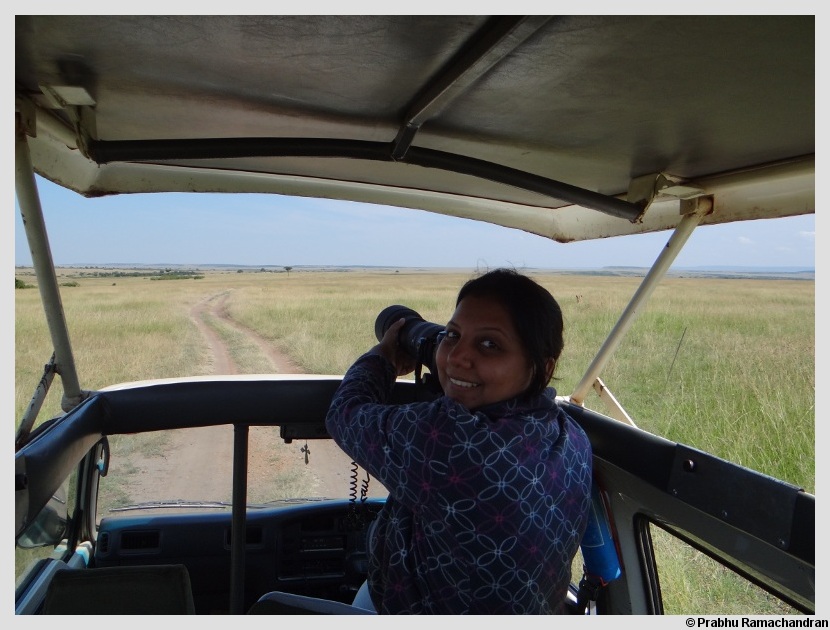
Yours truly, on safari - watching lions hunt a topi
The Mara is home to about 60 species of mammals and nearly 500 species of birds. This implies an astonishing wealth of biodiversity. Let me help you appreciate these numbers better - India (a country many times the size of Kenya) on the whole has about 1300 species of birds while this one national park accounts for more than a third of India's avifaunal diversity!
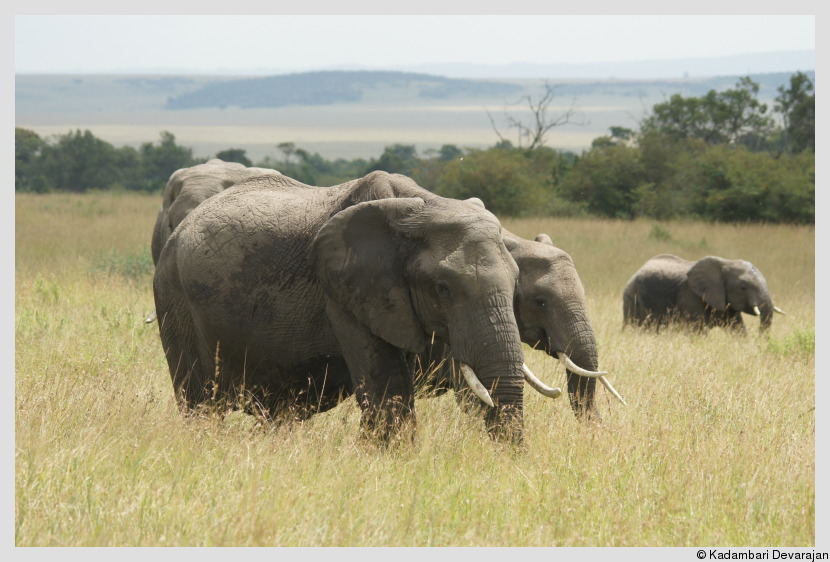
From the 'big five' list: the African elephant
All members of the so-called "big five" mammals, namely the lion, leopard, black rhino, African elephant and African buffalo, are found here. Of these, only the black rhino is considered endangered while sizeable populations of the rest exist in the Reserve.
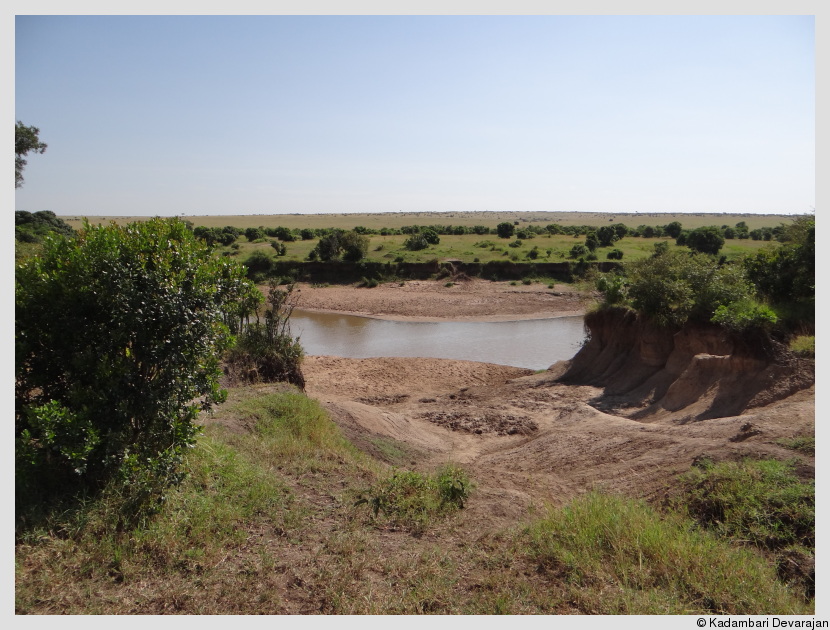
The Mara river inside the park
The Mara and Talek rivers harbour sizeable populations of hippopotami and Nile crocodiles. Six species of wild cats, out of about 25 species of carnivores typically found in the region, can be found here. The Mara, however, is most famous for the annual migration of wildebeest, zebras, and gazelles. The migration is considered such a spectacle that it has been christened as the 'great migration'.

Hippo mom with her calf
In July, year after year, these herbivores start heading north towards the Mara, from the parched Serengeti lands, in search of fresher pastures. They make the return trip in October, traversing through the same plains once again. During this time, they pour across the border in a seemingly endless and surging column of life, stomping, feeding, and modifying the savanna.
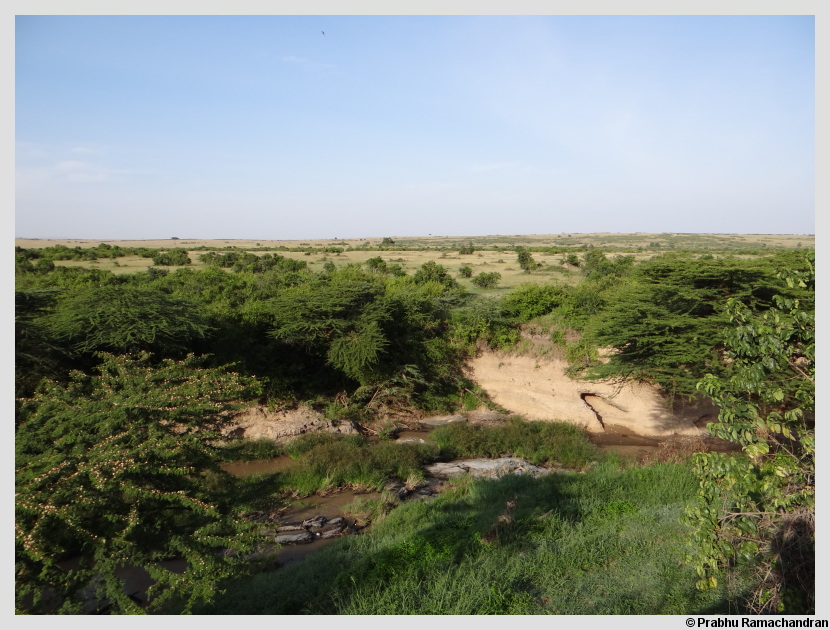
A view of the Mara plains from the Ilkeliani Camp

White-bearded wildebeest
The ungainly wildebeest are usually the first to start this migration and are so numerous that row after row of these antelope would stretch into the horizon, as far as the eye can see. They encounter a major bottleneck at the Mara river and crowd together on its banks before plunging into the perilous flow, where the Nile crocodiles lie in wait in the muddy, raging waters of the narrow river. There is frenzied drama and edge-of-the-seat action in the turbulent waters as they fight against the swift currents and the predators lying in wait.

Jackal among the herds
These migrating herbivores are invaluable to the ecosystem for many reasons. They help fuel a cycle of regeneration of the grasslands and bring new life to the Mara. Just as important, they don't travel alone, and the predators that follow the teeming herds, on their course from the Serengeti to the Masai Mara, help restructure and reshuffle the existing faunal and floral communities.
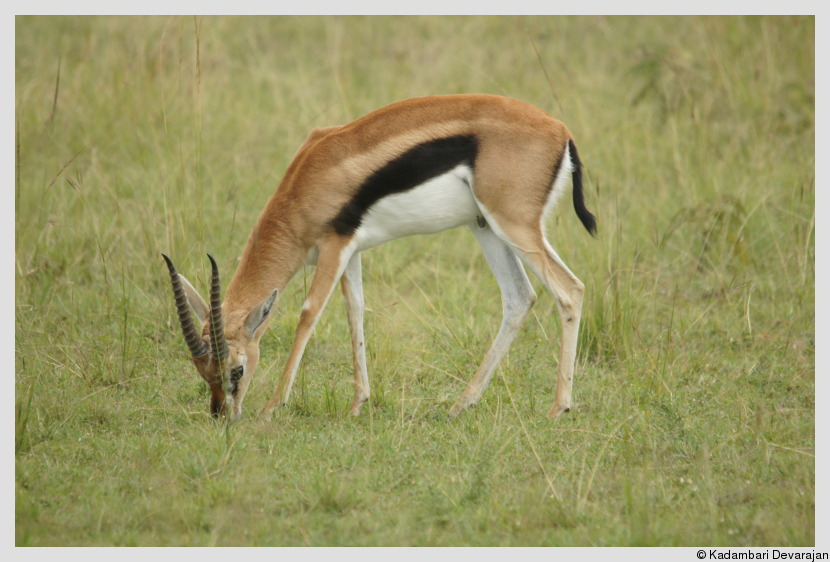
Thomson's gazelle grazing
The Masai Mara is the ultimate natural spectacle, a region that fosters coexistence, at least from the outset, between the regal Masai warriors and the resident fauna. It is a breathtaking landscape that is chockful of predators, magnificent herds, and alternating natural cycles of life, death and regeneration. Life is kingsize in the Mara.
Ilkeliani Camp
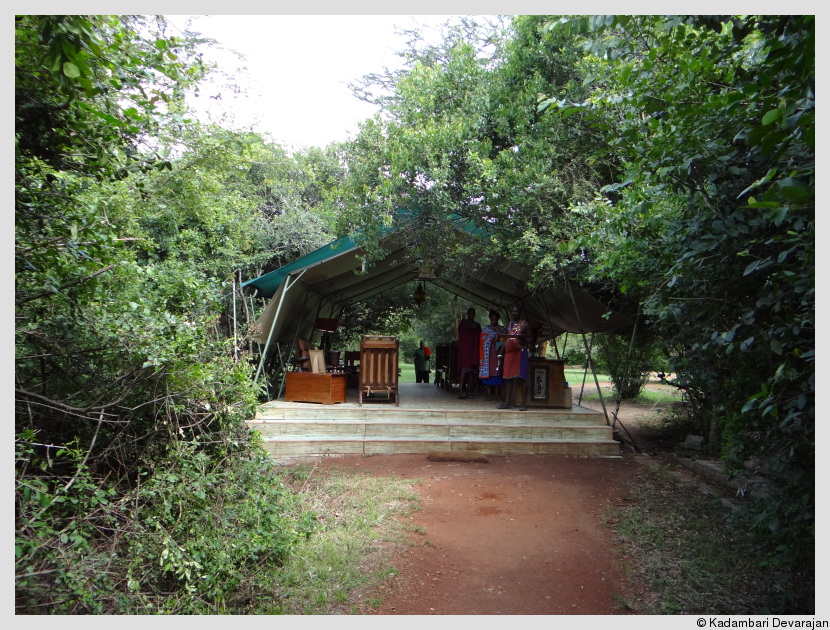
The reception at Ilkeliani Camp
The Ilkeliani Camp on the banks of the river Talek, is a permanent, luxury, tented camp that is located in the Masai Mara. It is just off the town of Narok and close to the Talek gate of the Mara Reserve. With just 17 tented rooms having attached bathrooms, it is a small but well-equipped establishment, having excellent service. Each room is slightly elevated and on an earthen mound, so as to ensure commanding views of the Mara plains and the Talek river.
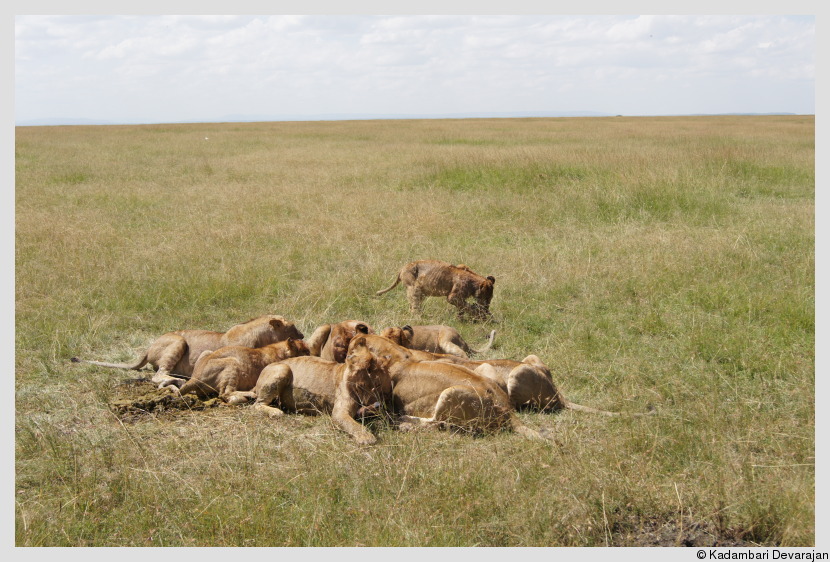
A pride of lions feeding on a topi in the Mara
The structures were built in an eco-friendly and unobtrusive manner, with each tent secluded from the rest and under the canopy of indigenous trees. However, this meant there was no electricity in the tents and we used to charge camera batteries in the charging points in the common area. A hot shower was possible anytime of the day with briquettes made from coffee husk locally that supposedly burn for longer than charcoal. At night, each room had a traditional Masai warrior stationed outside, spear in hand, to watch out for marauding wildlife. The camp gets its name from these warriors - Ilkeliani is the term for the young warriors who are yet to become the Il Moran. This added some character and charm to the camp.
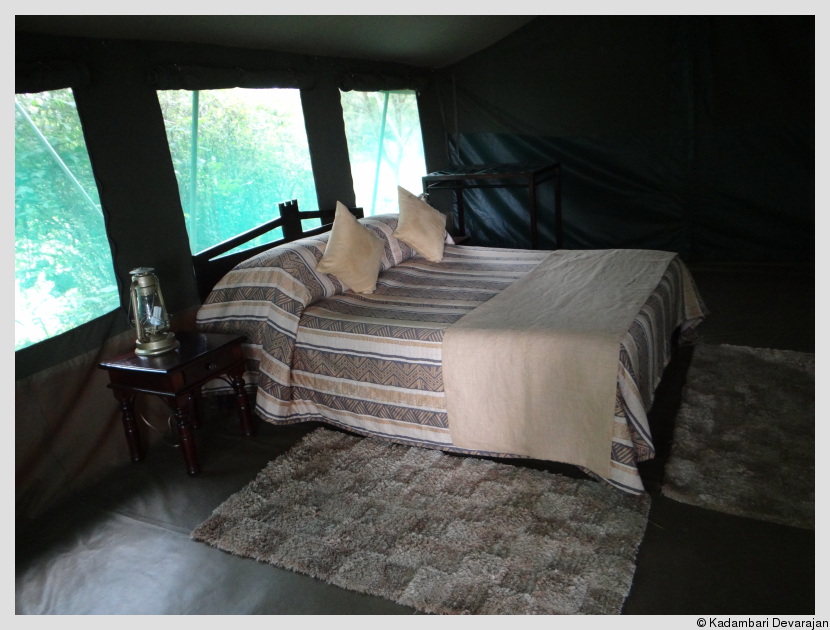
Our tent at the camp
Our tent was tucked away in one corner of the property, right on the river bank. The tents were mostly hidden from each other since they were nestled under clusters of shady trees, all atop a riverine glade. This guaranteed privacy and a feeling of being in the wilderness, that was accentuated at night with sounds from the animals in the Mara.
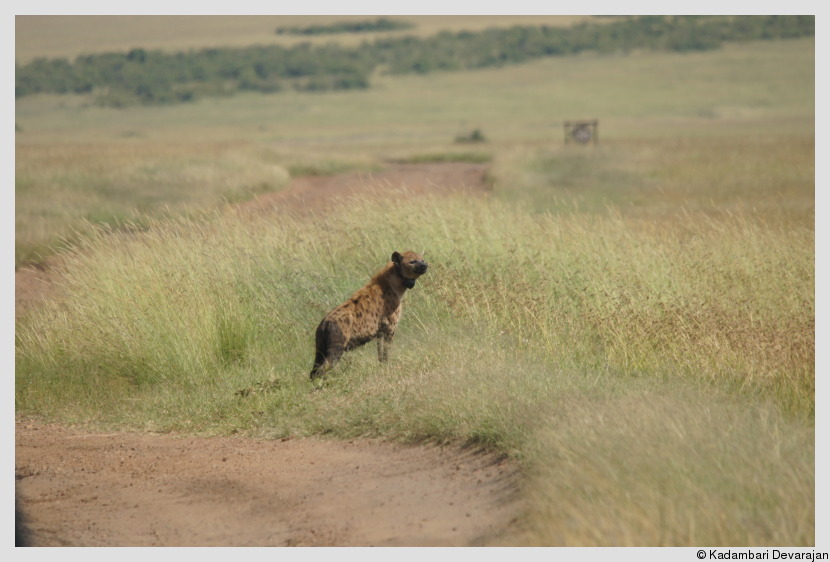
Spotted hyenas could be heard at night from our room
Our tent had a private porch from which one could comfortably watch the sunset or birds around the Talek river, sundowners in hand. We would drift off to sleep each night with a miscellany of sounds from across the river - the eerie calls of the hyenas, the guttural roars of the lions, and the deep rumbling of elephants. Dawn would be accompanied by the cacophonous riot of birds.
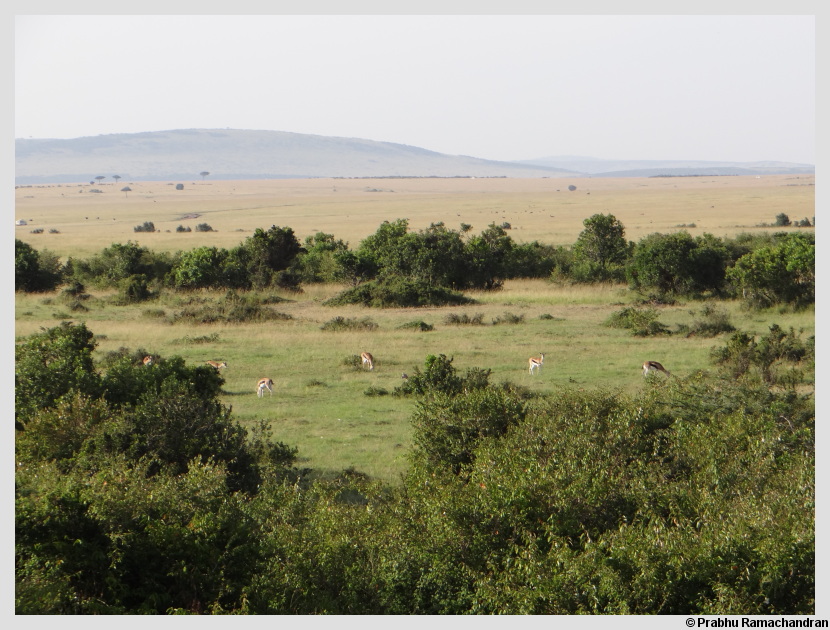
A view of the Mara plains across the Talek river from the camp
The common area had lounge chairs facing the Masai Mara plains, across the narrow Talek river. It was the perfect place to rest tired feet and enjoy some sundowners or tea after a long day's safari. They also had some diwans to stretch out on, an assortment of indoor games, a small library with books on the region, its people and wildlife, a reasonably well-equipped bar, and a couple of charging points for recharging batteries.
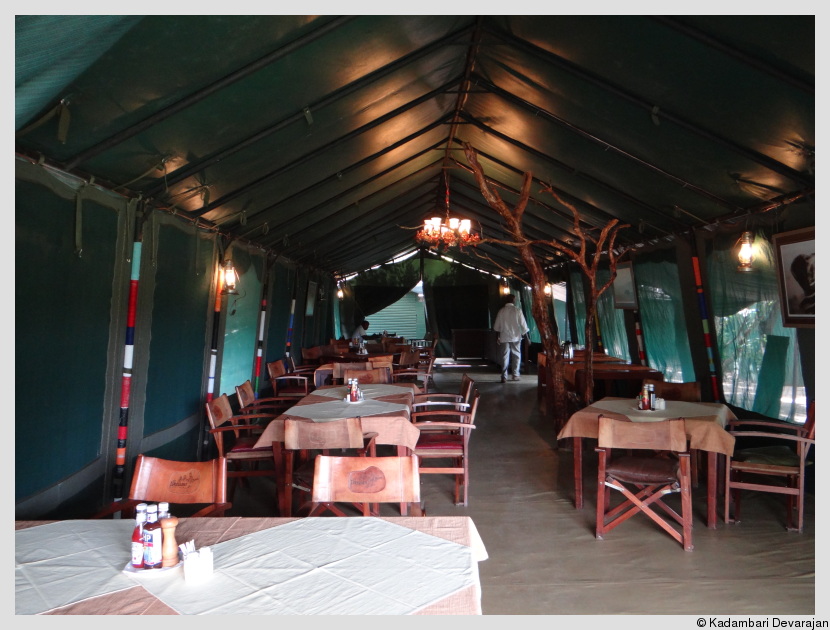
The dining hall
Most establishments in Kenya include all meals in their tariff and the Ilkeliani was no exception. The camp's kitchen offered alfresco dining on most days, with hearty breakfasts and candle-lit dinners, as well as sumptuous packed breakfasts and picnic lunches to have during a safari.
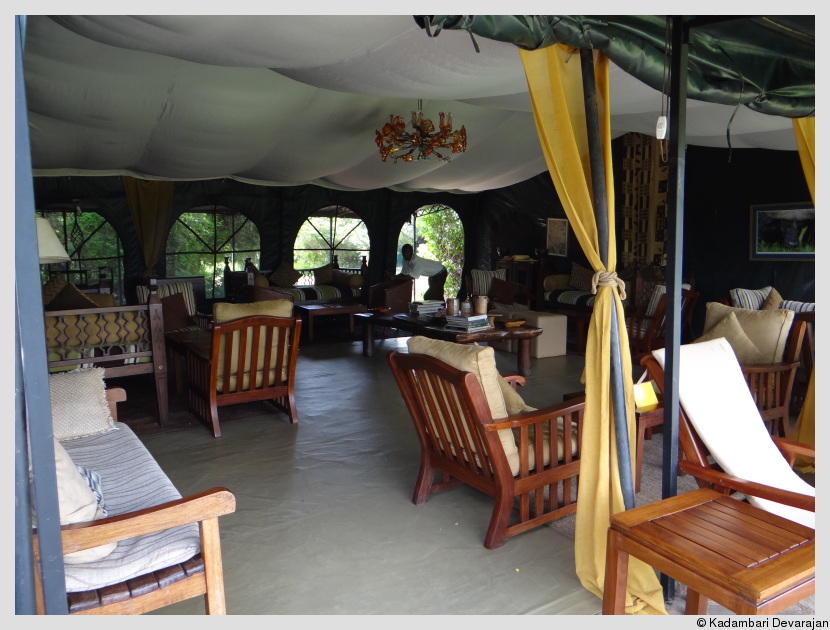
The common area
There is usually a bonfire after sunset to complete the safari experience - the perfect way to unwind, a Tusker beer in hand. A sundowner and some snacks such as potato crisps or peanuts were usually served before supper. After dark, the property takes on a romantic blanket, for all the tents, the common area, and the dining hall are candle-lit. The rest of the property is clothed in darkness and a Masai warrior, lantern and spear in hand, accompanies us to our tents after meals.
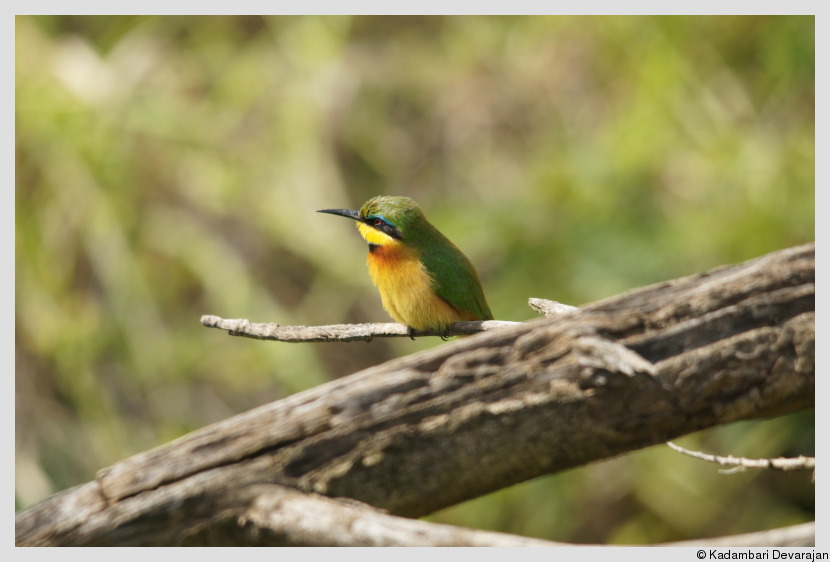
Cinnamon-chested bee-eater -- bird-watching while dining
The food is freshly made, and typically from local grocery and vegetables. I found the food to be very tasty and the chef wonderfully accommodating of special requests. We could enjoy watching birds flitting from tree to tree near the Talek river, and occasionally watch antelope or elephants graze on the Mara plains, across the river, while eating.

A trio of topis in the savanna
The packed breakfasts and lunches were thoroughly enjoyable too, with a picnic basket to boot! There would usually be some sandwiches or rolls, a fruit, a slice of cake or some cookies, some juice, flavored yoghurt, and a packet of crisps or peanuts, along with anything else the creative chef decided we may like.
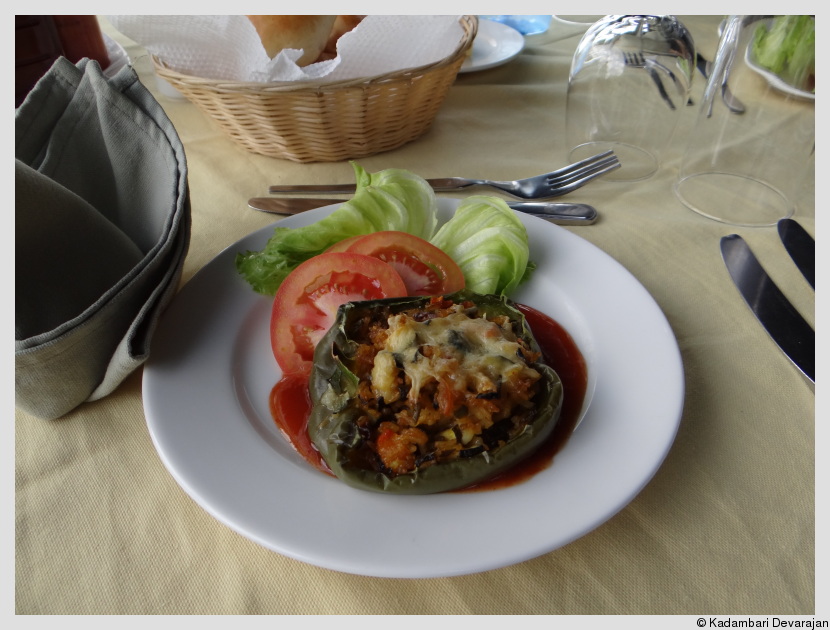
Alfresco lunch
Mammals
Out of about 60 species of mammals found in the Mara, we saw 28. Of the 'big five', we were able to see only three, and failed to see the black rhino and leopard in the Mara.
Cats
There are six species of wild cats in the Masai Mara conservation area: the African wildcat (Felis libyca), the serval (Lepitailurus serval), the caracal (Caracal caracal), the leopard (Panthera pardus), the lion (Panthera leo), and the cheetah (Acinonyx jubatus). Of these, we managed to see the cheetah and the lion multiple times in the Reserve, and an African wildcat near lake Naivasha, during this visit to Kenya.
1. East African Cheetah (Acinonyx jubatus raineyii)
The cheetah (Acinonyx jubatus) needs no introduction to most people. Even a child would recognize the fastest land mammal on earth. It is a large felid that is commonly found through many parts of Africa, especially in sub-Saharan savannas, in addition to Iran.
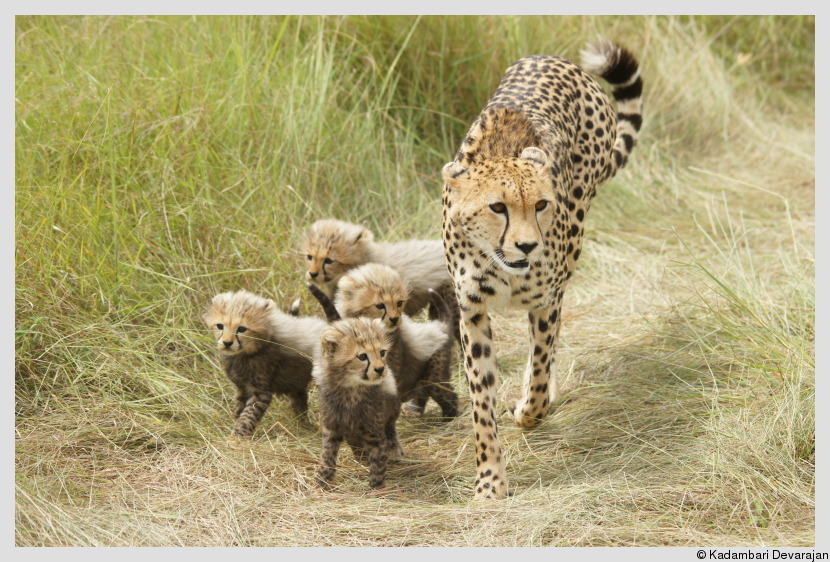
Cheetah with cubs
It is thought to be the only extant species of the genus Acinonyx. There are about five known sub-species of the cheetah, namely: the Asiatic cheetah (Acinonyx jubatus venaticus; currently found only in Iran with less than a hundred individuals thought to exist in the wild and considered extinct in most of its former range in Asia), the northwest African cheetah (Acinonyx jubatus hecki; scattered populations in northwest and western parts of Africa), the east African cheetah (Acinonyx jubatus raineyii; sizable populations found across east African savannas), the southern African cheetah (Acinonyx jubatus jubatus; found in most southern African countries), and the central African cheetah (Acinonyx jubatus soemmeringii; pockets of central Africa).

A female cheetah, right on track
The critically endangered Asiatic sub-species is extinct in many parts of its former range, notably India, where the last three were shot in the year 1947 by the Maharaja of Surguja in the state of Madhya Pradesh. It was popularly called the 'hunting leopard' in colonial India and was an integral part of royal hunting parties, either as victim or as assistance, especially in bringing down birds. We saw the east African sub-species which is commonly found in arid and semi-arid parts of eastern African countries such as Kenya, Tanzania and Uganda, as well as grasslands in the region.
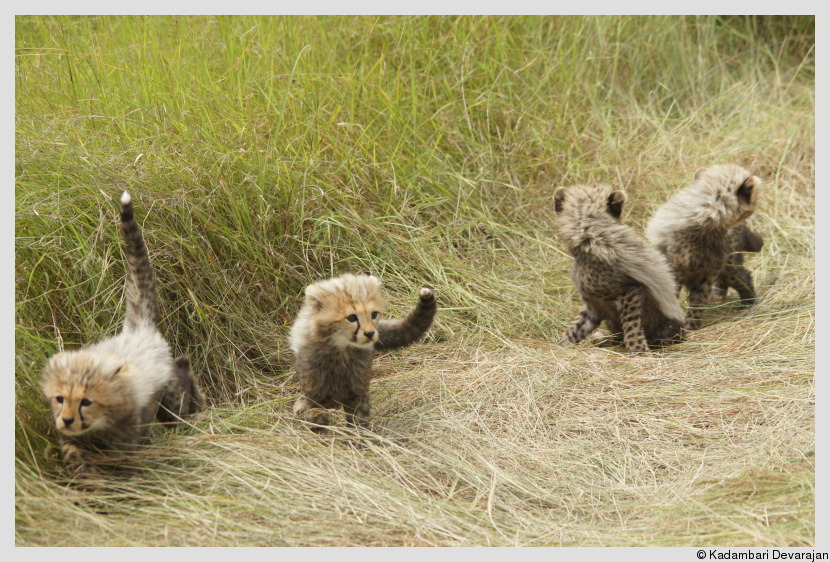
Cheetah cubs frolicking
During this trip, we saw three cheetah adults and four cubs. We saw a cheetah sitting on a mound, which is routine behavior for these cats, at a distance on the first evening drive in the park. The higher elevation of such mounds help act vantage points from which the cheetah can survey the savanna for potential prey.
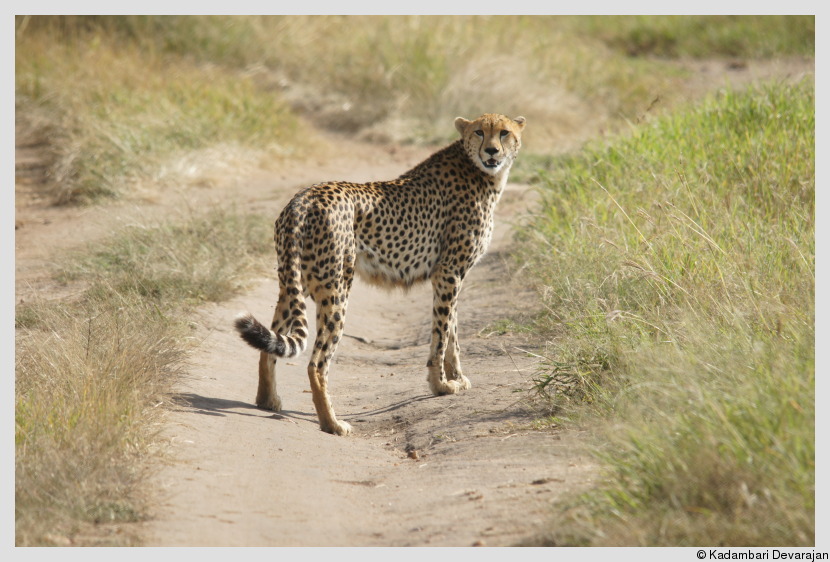
The Spotted Sphinx, in the words of Joy Adamson
We saw a cheetah with her four cubs on the second day, as well as a single female cheetah later in the day.
The Spotted Sphinx section in my big cat diary has more photographs of cheetahs encountered during this trip.
2. African lion (Panthera leo)
Lions form an integral part of jungle lore and safaris. Every child would recognise the lion as the 'king of the jungle' and (arguably) the most charismatic of the big cats. They are widely distributed across sub-Saharan Africa with an Asiatic sub-species (comprising of a single endangered population) found in the Gir forests of Gujarat in India. They are emblematic of the African grasslands, especially after the popular character Simba from the Lion King musical. Lions are well known as the most social of the felids and the only big cats of the genus Panthera (the others being the tiger, jaguar, and leopard) that are not solitary.
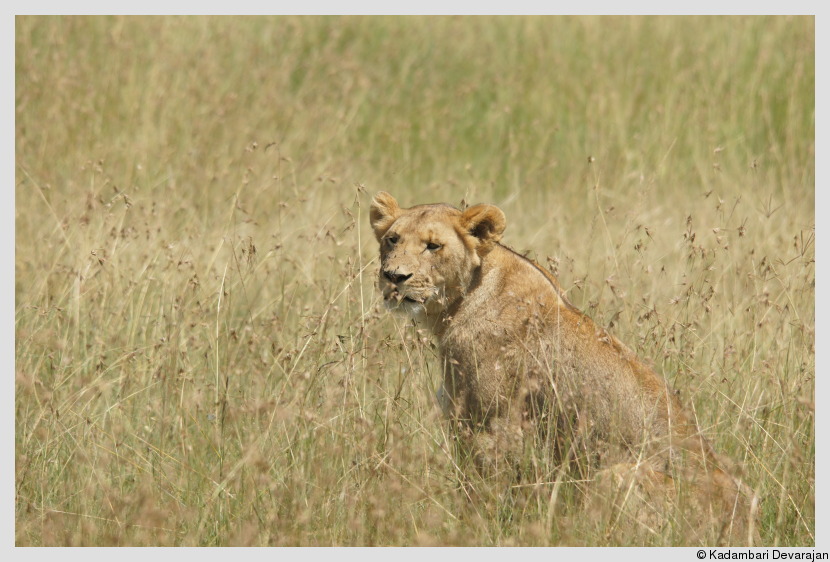
Lioness
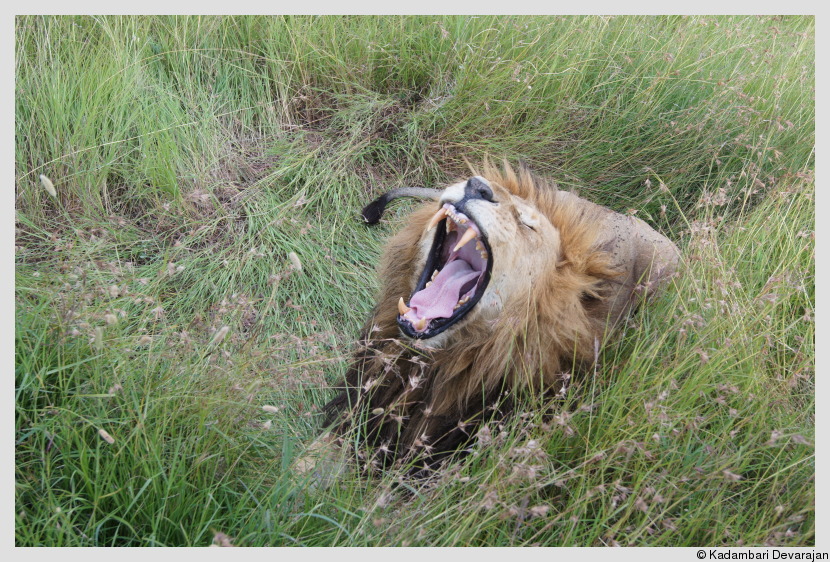
A royal yawn
Lions are the most common of the big cats seen in the Mara. We saw multiple lions on each drive inside the conservation area. This includes one episode of a lion mating with a lioness, and two instances of lions with a kill. The first morning drive in the park resulted in a sighting of a lioness sitting next to a dead African buffalo, possibly one she had hunted during the wee hours. Some scavengers swung by to take a look and circled the area for a while. The first to inspect the crime scence was a spotted hyena. This was followed by another hyena, a duo of black-backed jackals, and finally some vultures. On the third day, we were also lucky enough to watch a pride of lions hunt down a topi. We followed the pride for more than two hours, from the time they started stalking the topi till the arrival of scavengers. The first scavengers to arrive on the scene were black-backed jackals, followed by vultures which were still circling above, when we left the lions to feed in peace. This was one of the most memorable parts of the trip.

A lioness in the savanna
The lion section in my big cat diary has more pictures of lions from this trip, including a montage of a pride of lions hunting down a topi.
Hyenas
There are two species of carnivores belonging to the family Hyaenidae that can be found in the Mara. These are the spotted hyena (Hyaena hyaena) and the aardwolf (Proteles cristata). Comprised of only four species, namely, the spotted hyena, striped hyena, brown hyena, and aardwolf, Hyaenidae is one of the smallest families of mammals.
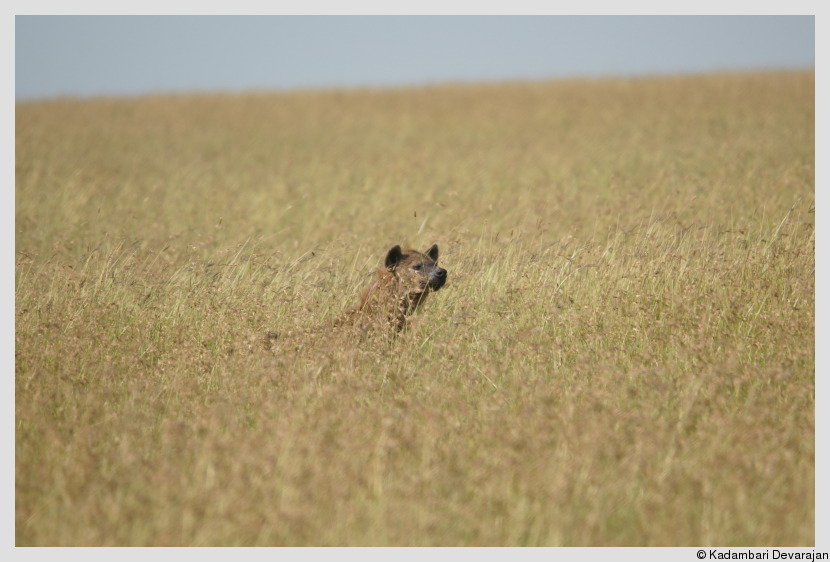
A spotted hyena in the savanna
The species are widely distributed across Africa and parts of Asia, extending upto India in the case of the striped hyena. The spotted hyena is the most common and widely distributed of the hyenas, while the aardwolf is restricted to pockets of southern and eastern Africa.
Spotted hyena (Hyaena hyaena)
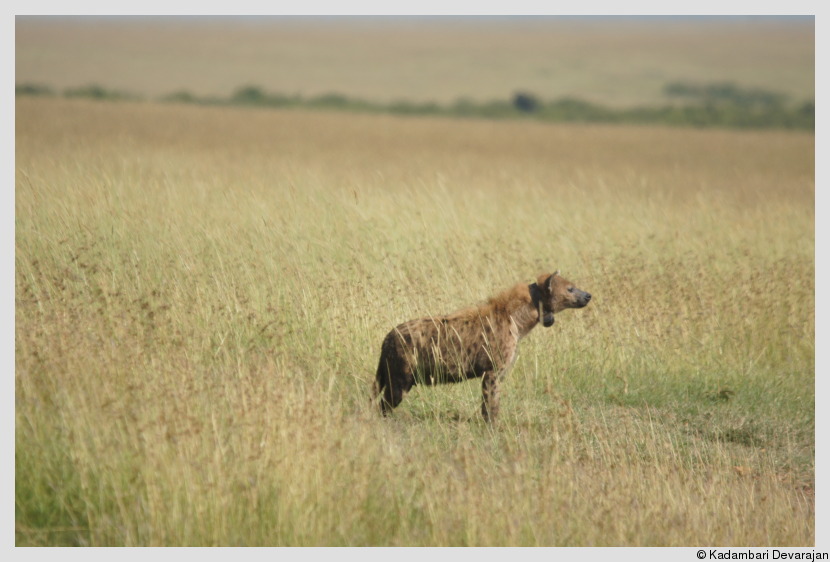
A spotted hyena that had been radio-collared
Although widely disregarded as scavengers, hyenas are excellent predators and hunters. Despite having low genetic diversity, they are integral to many African (and some Asian) ecosystems filling unique roles and niches. While they are distinct and different from both canids and felids, they are behaviorally and morphologically more similar to canids and are thought to have complex social systems. Mark and Delia Owens' pioneering study of brown hyena society and social structure is chronicled in the book, Cry of the Kalahari. It includes the Owens' experiences studying brown hyenas and their social structure in Botswana, and is one of my favorite natural history books.
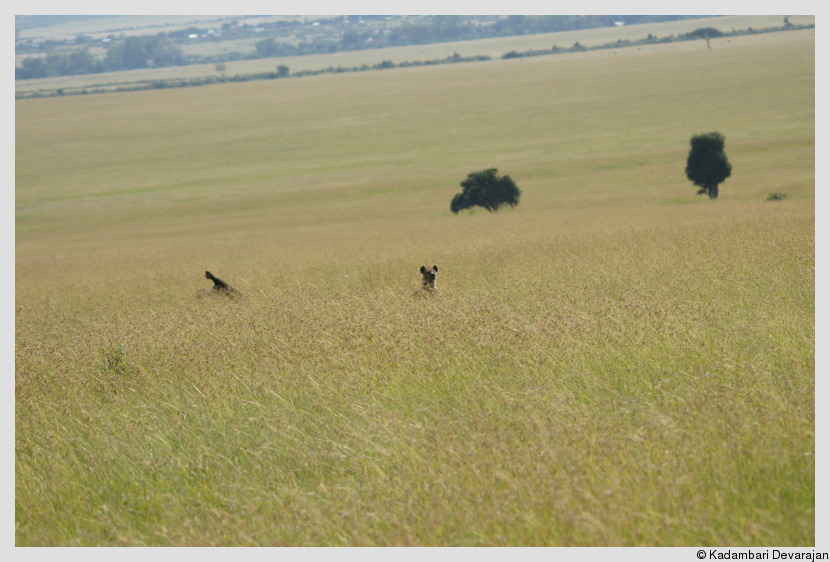
A spotted hyena near a lioness with her buffalo kill

The portrait of a spotted hyena
Foxes, jackals, and dogs
Four species of canids can be found in the Masai Mara. These include the bat-eared fox (Otocyon magalotis), black-backed jackal (Canis mesomelas), side-striped jackal (Canis adustus), and African wild dog (Lycaon pictus). Of these, we frequently encountered black-backed jackals, usually at or near carcasses, typically lion kills. We may have seen a side-striped jackal once, but are unsure of the sighting. While bat-eared foxes are common in the Mara, we were unable to spot them. However, we did manage to sight these social animals at sunset when leaving Hell's Gate National Park near Lake Naivasha. Of the canids, both species of jackals are solitary, while the fox and wild dog are social. The Mara is one of the few landscapes where multiple canids co-exist, for it is truly rare to find intra-guild carnivores existing sympatrically.
Black-backed jackal (Canis mesomelas)
This is a species that is found in two distinct pockets of Africa - countries in the south (from South Africa to Zimbabwe) and the east (Kenya, Ethiopia, and Somalia). There are two sub-species of black-backed jackals, namely the cape jackal (Canis mesomelas mesomelas; found in southern Africa) and the east African jackal (Canis mesomelas schmidti; found in east Africa). The latter sub-species is found in the Mara and other parts of Kenya. Of the three species of jackals found in the world (black-backed, side-striped, and golden), they are the smallest in size. They are easily distinguishable from the side-striped with their black-tipped tails while the side-striped have a white tip in their tails. They are behaviorally similar to the golden jackal and thought to fill the same ecological niches.
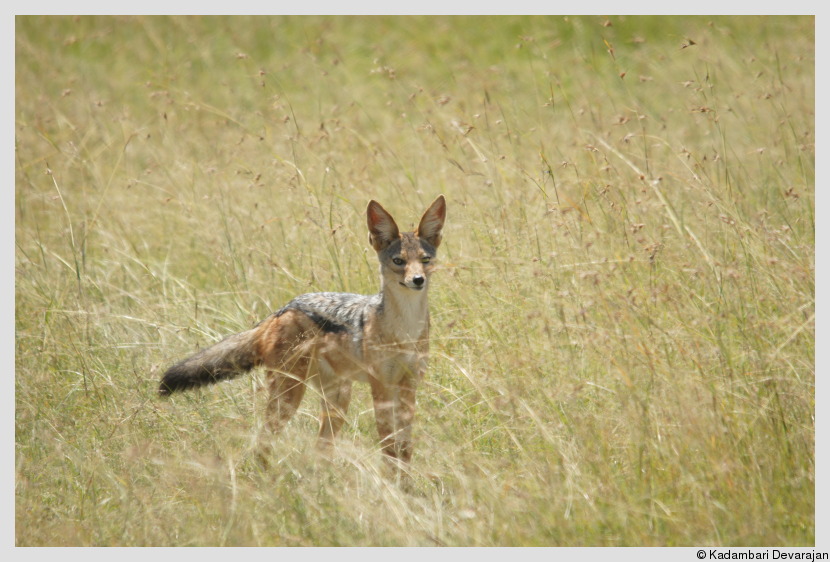
A black-backed jackal in the savanna
They are omnivorous and feed on invertebrates, small mammals such as rodents and hares (and occasionally even young antelope), small reptiles such as lizards and snakes, small birds (although there are records of these jackals killing and eating even Kori bustards), and small carnivores such as small wild cats, mongooses, and polecats, in addition to carrion as well as fruits and tubers.
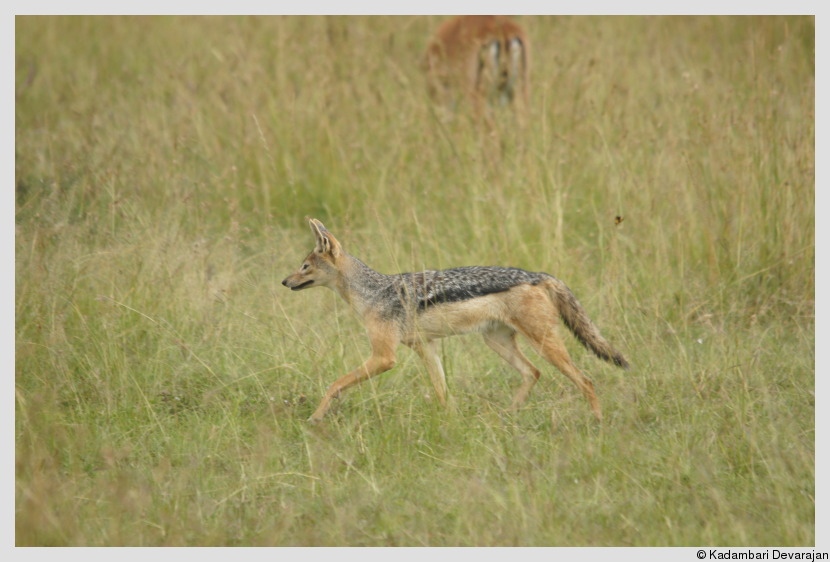
A black-backed jackal intent on its work
They are scavengers and can be commonly found near carcasses hunted by the larger predators. In coastal areas, they feed on fish, marine invertebrates, small marine birds, and small marine mammals such as seals.
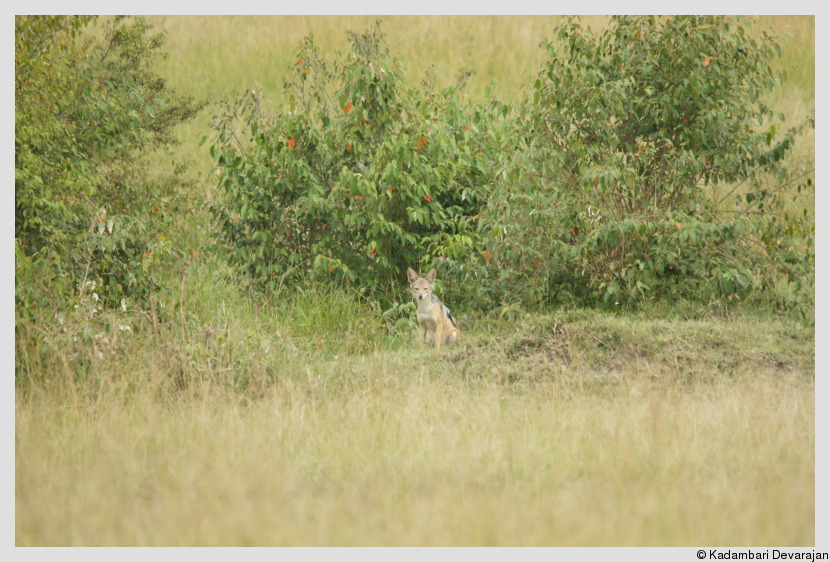
A black-backed jackal looking right back at me, characteristically
They frequently feature in folktales and fables of the tribes of the region, where they are portrayed as shrewd or cunning, usually outsmarting larger predators in their escapades. One tale of the Khoikhoi people proffers that the jackal got its black back after carrying the sun on its saddle. These days, they are considered a pest in some regions and often come in conflict with humans over livestock depredation.
Mongooses
There are an unusually high number of mongoose species co-existing in the Masai Mara. Not two, not three, but six species of mongooses can be found here. These are the Egyptian mongoose (Herpestes ichneumon), slender mongoose (Herpestes sanguineus), banded mongoose (Mungos mungo), dwarf mongoose (Helpgale parvula), marsh mongoose (Atilax paludinosus), and white-tailed mongoose (Ichneumia albicauda). Of these, we managed to see a band (that is apparently the right collective noun!) of banded mongooses in the Mara, and a slender mongoose when in Laikipia.
Banded mongoose (Mungos mungo)
The banded mongoose is found in most parts of central and east Africa. It is primarily insectivorous and commonly found in open savannas, but also feeds on small reptiles and birds, as well as bird and reptile eggs. Unlike most species of mongooses around the world which are solitary, they are unique in their colonial living with complex social structures. They forage in groups but each individual forages for itself. We spotted one such colony or band foraging together in the late afternoon (their typical foraging time, along with mornings) in the Mara in a grassland patch with short grass, not very far from their dens (we could see them scuttling into some termite mounds for shelter).
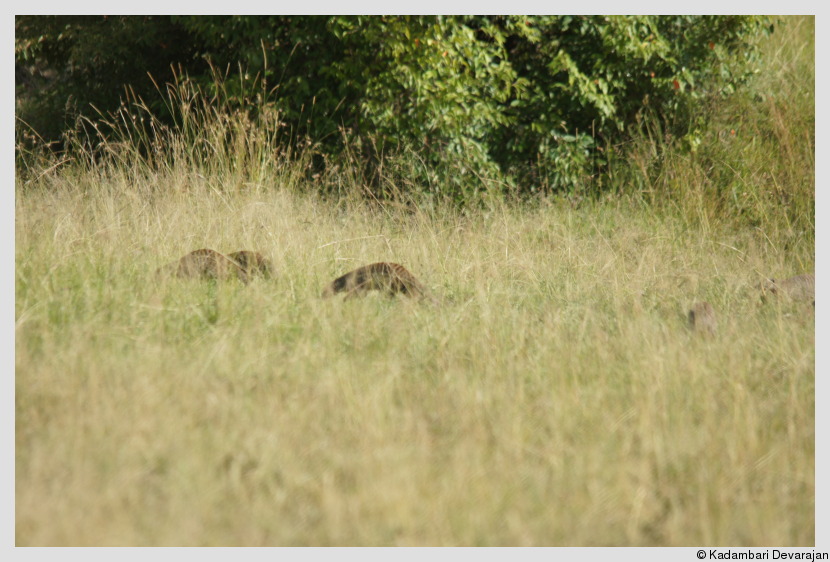
A band of banded mongooses scuttling away
Elephants
There are two species of elephants in the world - the African (Loxodonta africana) and the Asian (Elephas maximus). The African elephant, in turn, has two extant sub-species - the African bush elephant (Loxodonta africana africana) and the African forest elephant (Loxodonta africana cyclotis). This nomenclature is debatable with some researchers classifying the two as distinct species namely Loxodonta africana and Loxodonta cyclotis. I won't get into the nitty-gritty of the debate and will refer to them as sub-species for now.
African elephant (Loxodonta africana)
The African bush elephant is the largest terrestrial animal in existence today, followed by the Asian elephant, while the African forest elephant comes third, being much smaller than the former. The African bush elephant is the sub-species found in Kenya and healthy populations of the bush elephant exist in the Masai Mara.

A young African elephant
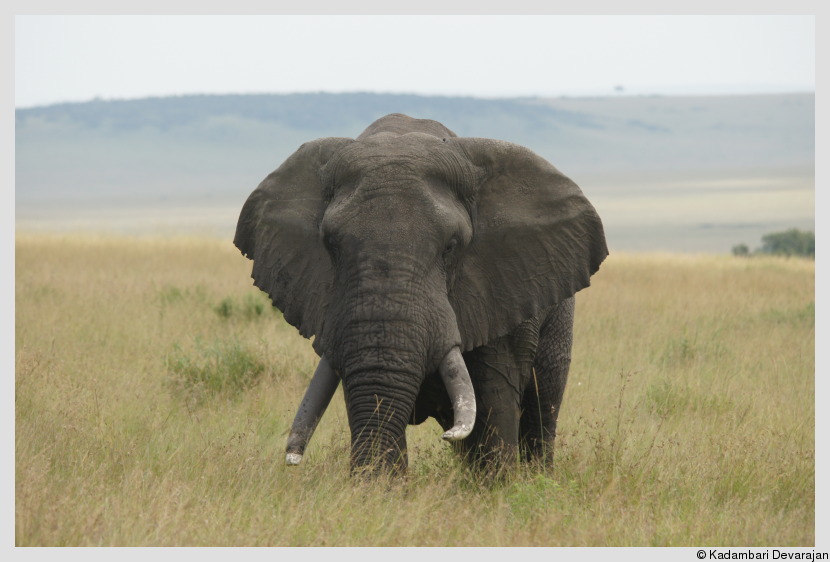
An adult African elephant
They differ in appearance from the forest elephant in size primarily, since the latter is considered a pygmy and much smaller in comparison. There are behavioral differences as well. On the other hand, there are numerous physical differences between the African bush and Asiatic elephants. The former is much bigger and has different cranial structure than the latter. Also, both males and females in the former have tusks while only male Asiatic elephants have tusks.
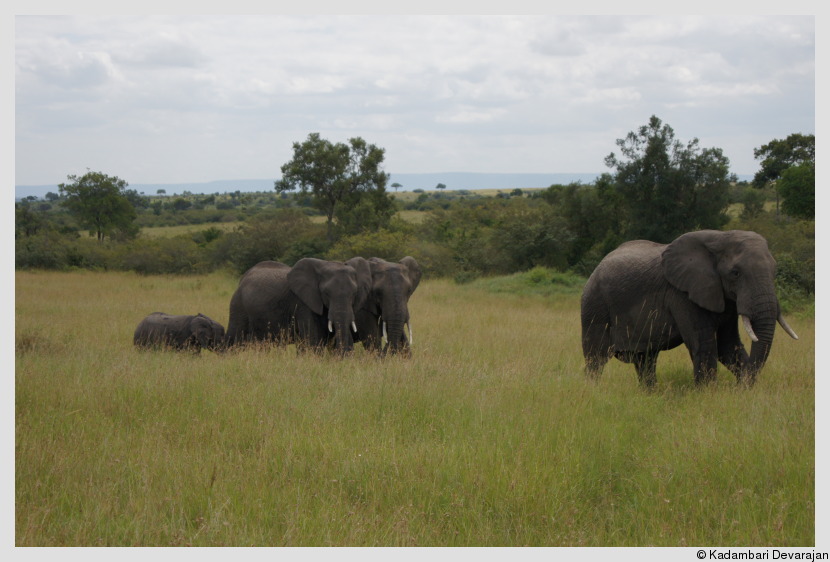
A herd of elephants

African elephant - adult with juveniles
Elephants are social creatures with herds typically comprised of related females and their young that are guided by a matriarch. Occasionally, adult males may join the herd for a short duration, but typically males leave the herd upon reaching adolescence and join a bachelor herd of similar age. Older males tend to be solitary and are known to approach female herds only during the mating season.
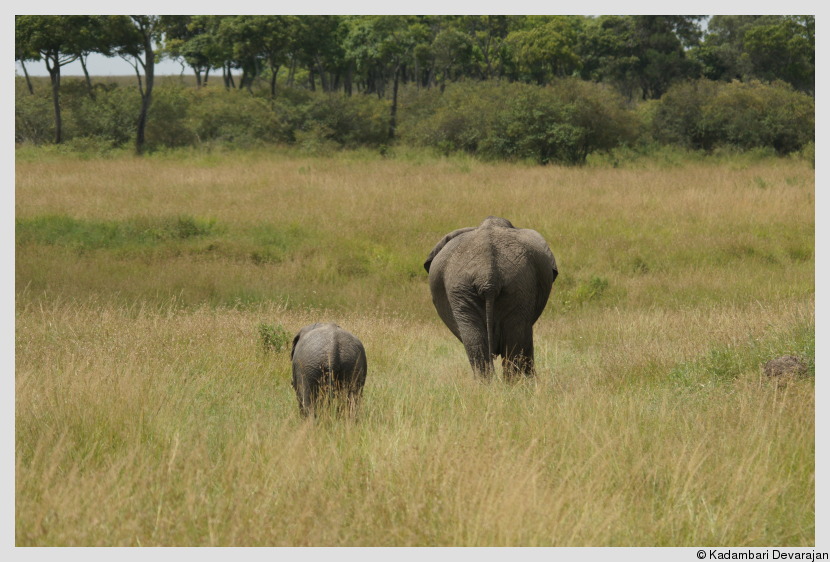
The wrong end of the elephant
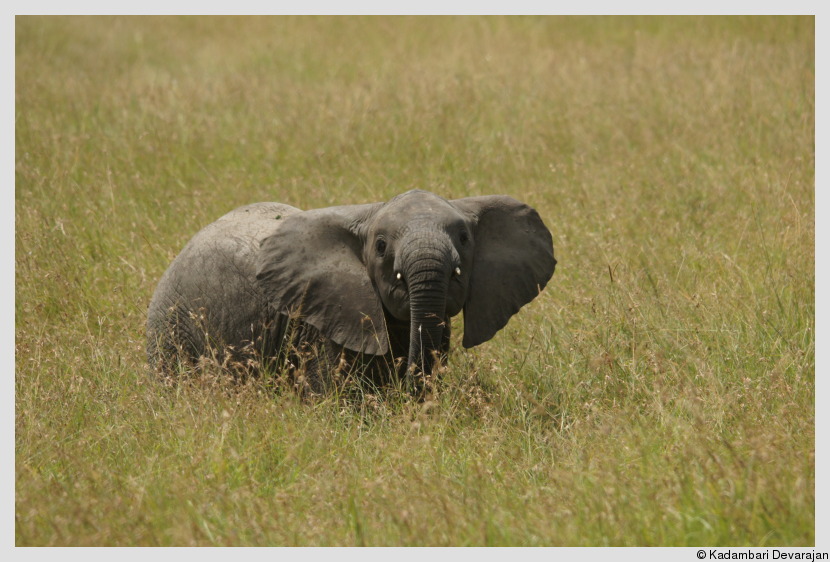
An elephant calf
This article by Mark Deeble nicely articulates the need to conserve elephants, with arguments that could be extended to many other life forms.
Giraffe
The giraffe (Giraffe camelopardalis) has nine sub-species, all of which are endemic to Africa. These include the Nubian giraffe (G. c. camelopardalis), reticulated giraffe (G. c. reticulata*), Kordofan giraffe (G. c. antiquorum), Angolan giraffe (G. c. angolensis), Masai giraffe (G. c. tippelskirchi), Rothschild's giraffe (G. c. rothschildi), South African giraffe (G. c. giraffa), Rhodesian giraffe (G. c. thornicrofti), and West African giraffe (G. c. peralta). Of these, the Masai giraffe, the reticulated giraffe and the Rothschild's giraffe can be found in Kenya. We saw all three sub-species during this trip to Kenya. We saw the reticulated giraffe in the Lake Nakuru National Park and the endangered Rothschild's giraffe at Crescent Island on Lake Naivasha, as well as in Laikipia. Healthy populations of the Masai giraffe can be found in the Mara.
Masai giraffe (Giraffe camelopardalis tippelskirchi)
The giraffe is well-known as the tallest terrestrial animal alive today. It is an even-toed ungulate (hoofed mammal) or artiodactyl and is the largest ruminant alive. The Masai giraffe is common across the savannas and grasslands of the Masai Mara, and typically feeds on acacia leaves. They are browsers and not grazers.
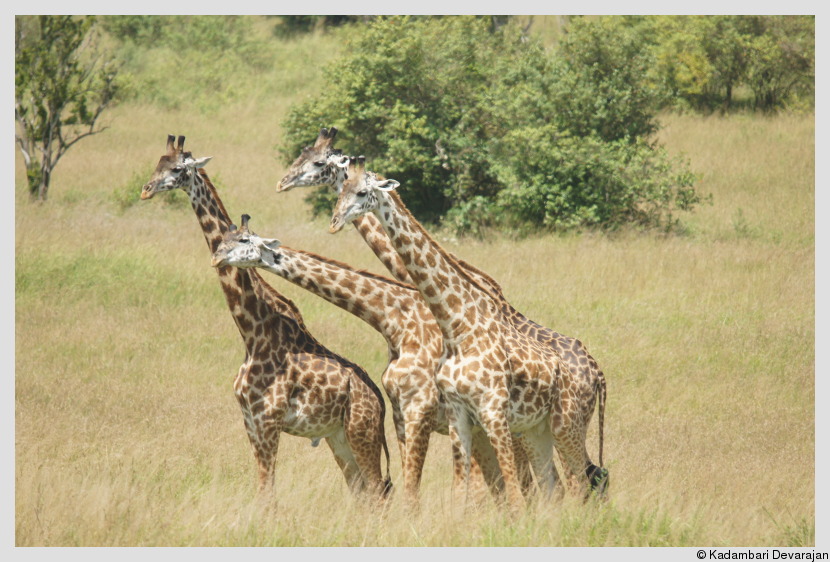
A corps of Masai giraffes

Masai giraffe in the savanna
The Masai giraffe is also called the Kilimanjaro giraffe and can be found in Tanzania and southern parts of Kenya. It has characteristic and distinctive jagged blotches on the skin that extend till the hooves. The males also have a median hump which the females don't.
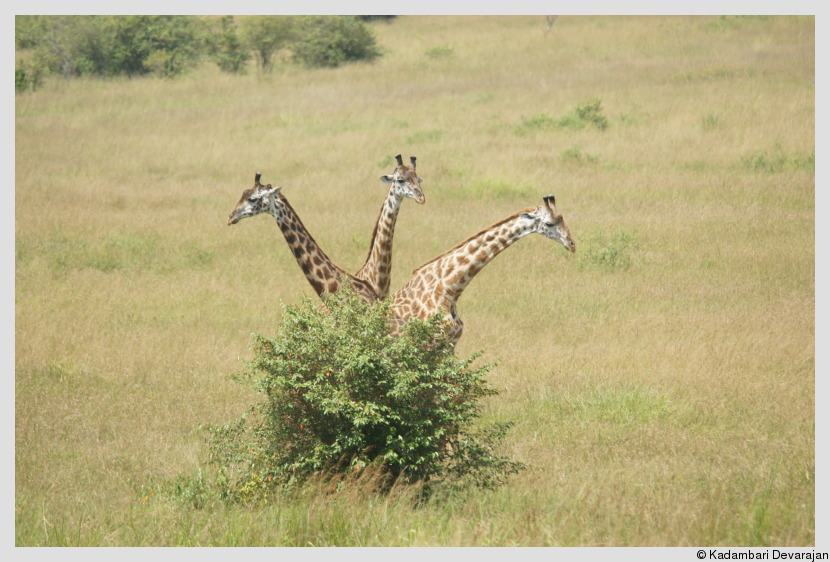
A trio of giraffes
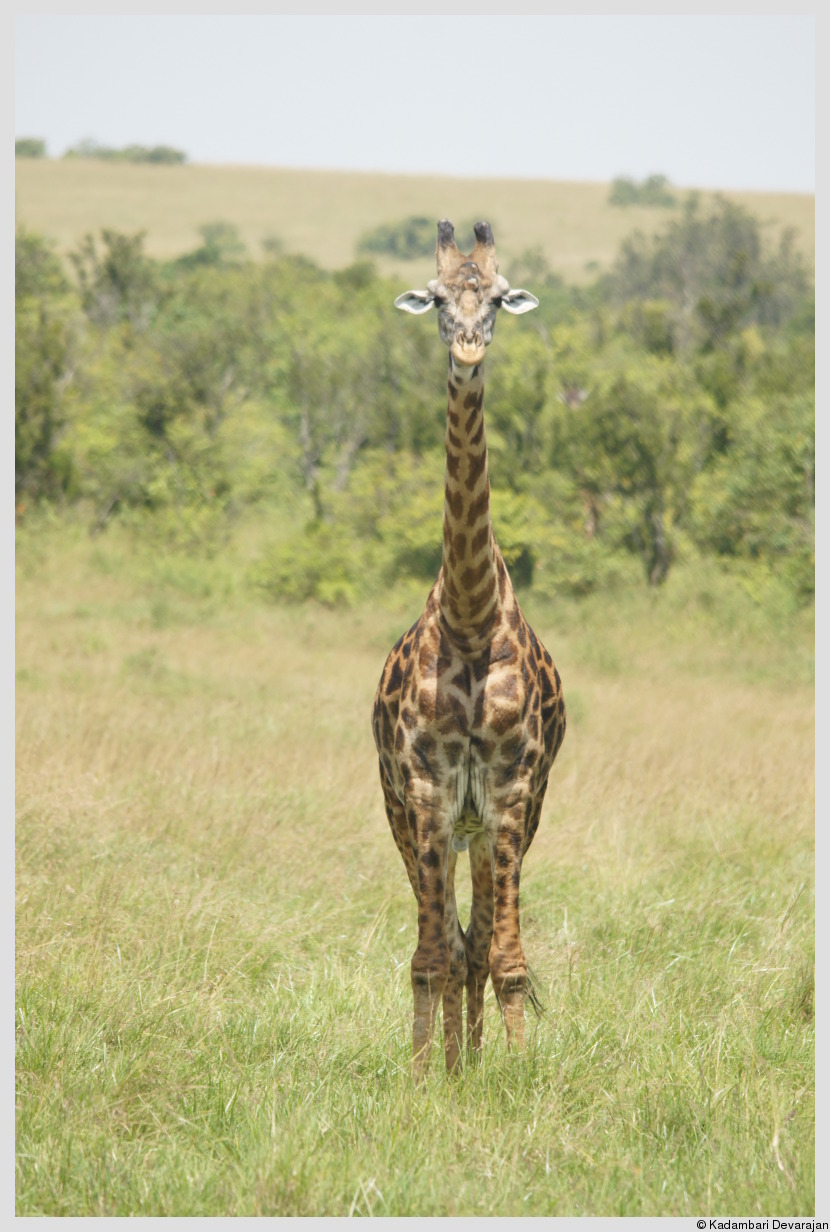
The portrait of a giraffe
The correct collective noun for giraffes is 'corps'.
Hippopotami
The hippopotamus is one of the largest land mammals on earth. It is also an artiodactyl, and in fact the heaviest even-toed ungulate on the planet. The word 'hippopotamus' is ancient Greek for 'river horse'. It is a large, semi-aquatic herbivore that is endemic to Africa and is widely distributed across rivers, lakes, waterholes, and mangrove swamps of sub-Saharan Africa.
Common hippopotamus (Hippopotamus amphibius)
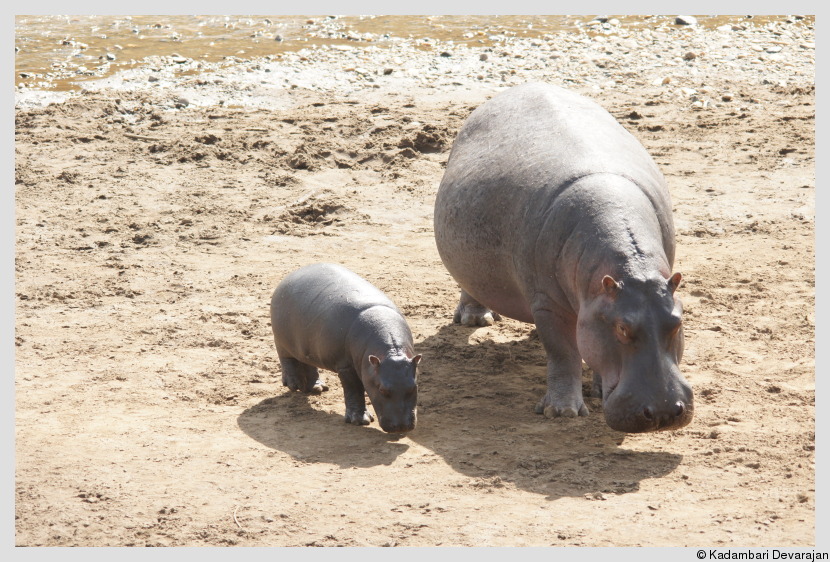
Hippos giving their "Don't mess with me" look
There are two extant species of the hippo, namely the common hippopotamus (Hippopotamus amphibius) and the pygmy hippopotamus (Choeropsis liberiensis). The common hippo is found throughout Kenya and healthy populations thrive in the Mara.

A happy hippo family at the Mara river
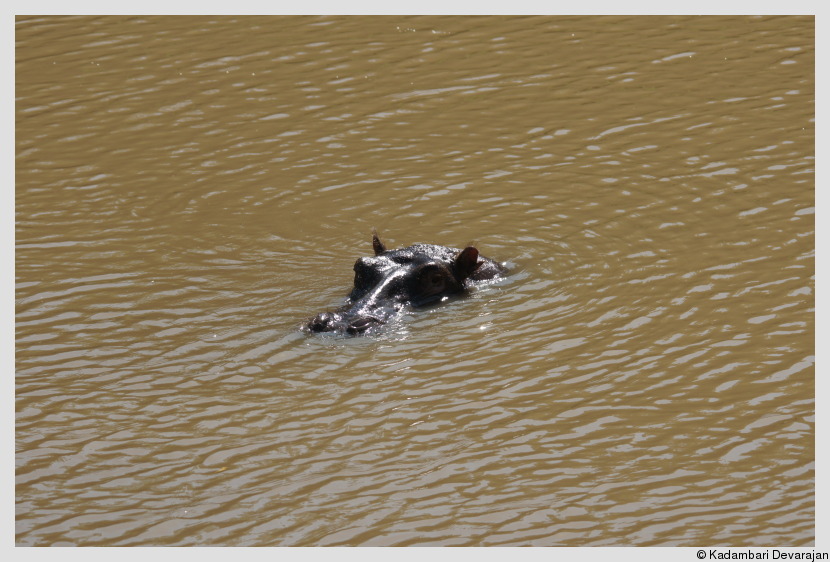
Hippo in the Talek river
Swine
The common warthog (Phacochoerus africanus) belongs to the wild swine or pig family. It is commonly found in grasslands, savanna, and woodlands across sub-Saharan Africa and has a wide distribution. It gets the name 'warthog' from the four large, wart-like protrusions that can be found on the head of the creature. There are four sub-species of warthogs, all of which are endemic to Africa. These include the Nolan warthog (P. a. africanus), Eritrean warthog (P. a. aeliani), central African warthog (P. a. massaicus), and Southern warthog (P. a. sundevallii). Of these, large populations of the central African sub-species can be found throughout Kenya, including the Masai Mara National Reserve.
Warthog (Phacochoerus africanus)
We saw the central African warthog (P. a. massaicus) numerous times on each drive inside the park. Each sighting would typically involve an adult male or a female with her piglets. The warthogs are omnivorous and their diet includes grasses, roots, fruits, bark, insects, and eggs, as well as scavenging on carrion occasionally. They are typically grazers that subsist on short perennial grasses.

A warthog in the bush

A warthog giving a pugilistic look
They live in groups called sounders comprising of females with their young, while the adult males leave the group but stay within the group's (typically large) homerange.
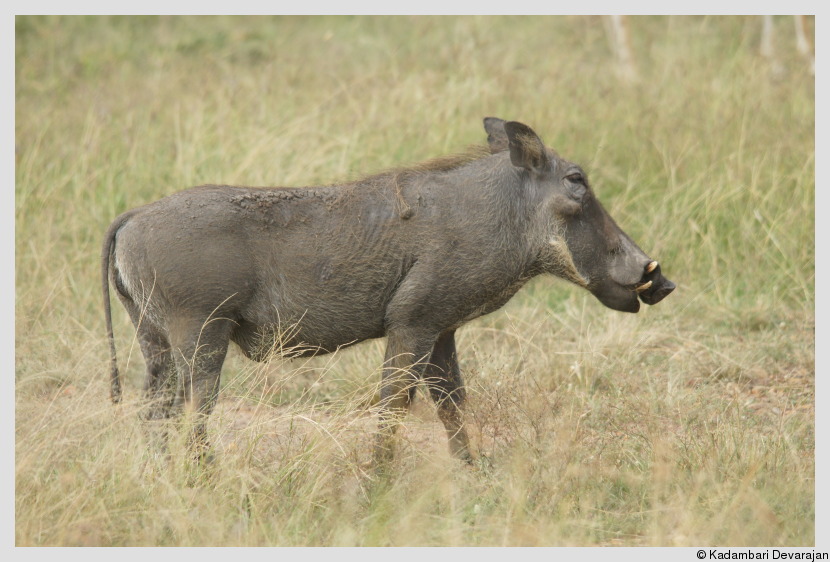
Warthog profile
Wild cattle
The only species of wild cattle found in Africa and endemic to it is the African buffalo (Syncerus caffer), which is also called the Cape buffalo. Unlike it's Asian counterpart, the Asian buffalo, it has never been domesticated. It has a wide distribution and can be found across most parts of sub-Saharan Africa, and can be frequently found in grasslands, savanna, and woodlands, in addition to swamps and floodplains.
The Wikipedia page mentions the following about the horns of the African buffalo: "The horns of African buffalo are very peculiar. A characteristic feature of them is the adult bull’s horns have fused bases, forming a continuous bone shield referred to as a “boss’, which can not always be penetrated even by a rifle bullet. From the base, the horns diverge, then bend down, and then smoothly curve upwards and outwards."
African buffalo (Syncerus caffer)
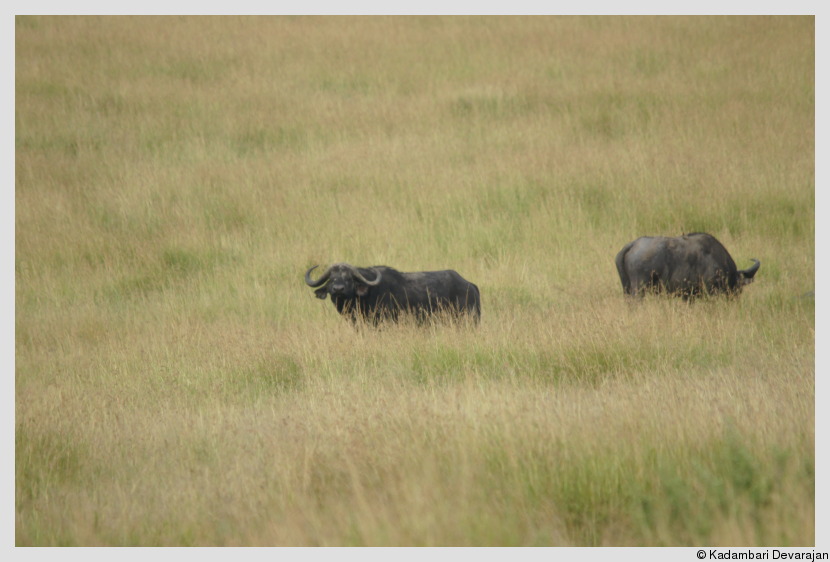
A duo of African buffalo
It is typically a grazer and is considered the most successful of African grazers, capable of surviving on tall, coarse grass that other herbivores find unpalatable. In fact, herds of buffalo mow down the coarse grasses in order make way for the selective grazers which follow. They are one of the 'big five' mammals in Africa.
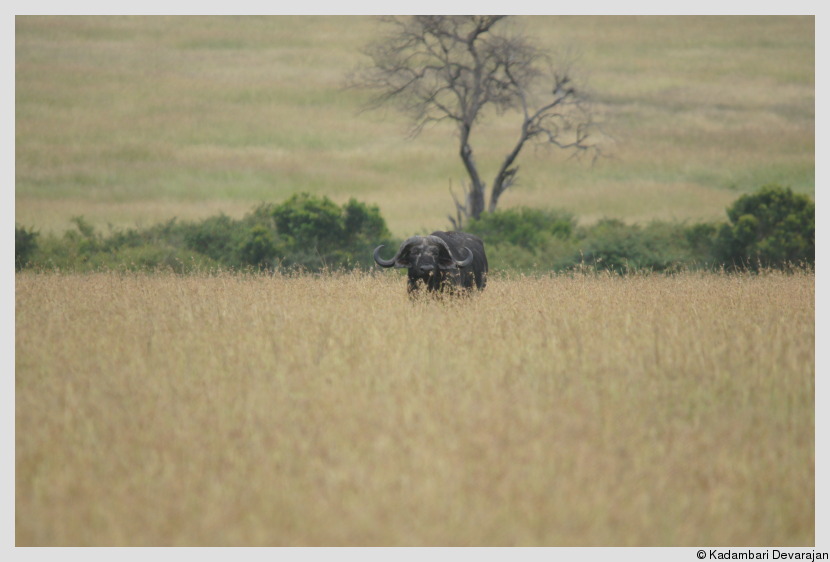
African buffalo with a stiff upper lip!
Horse antelopes
There are three species of horse antelopes found in the Mara. These are Coke's hartebeest (Alcelaphus buselaphus cokii), topi (Damaliscus lunatus jimela), and white-bearded wildebeest (Connochaetes taurinus). Of these, the Coke's hartebeest is solitary while the topi and wildebeest are social antelopes.
Coke's hartebeest (Alcelaphus buselaphus cokii)
This is an antelope that is endemic to Kenya and Tanzania. It is an even-toed ungulate (artiodactyl) that is typically solitary, and not very commonly found or easy to spot in the Mara.
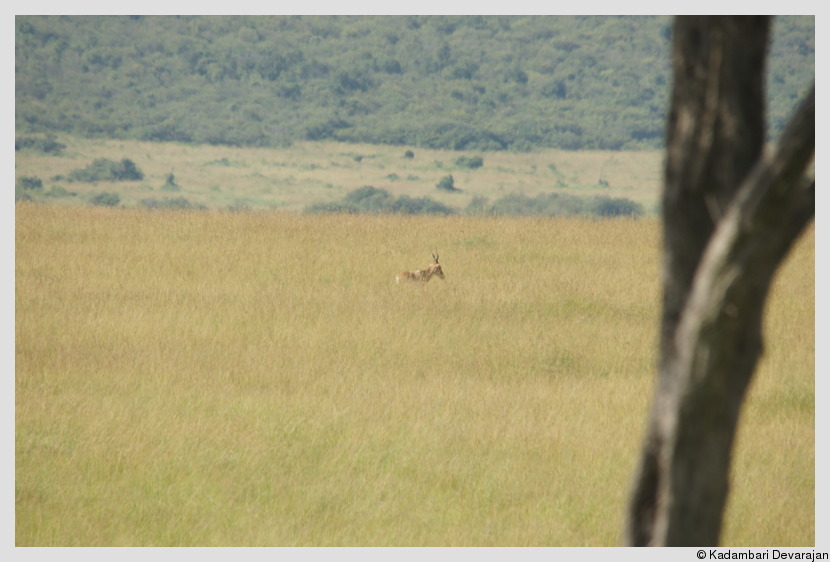
Coke's hartebeest
Topi (Damaliscus lunatus jimela)
This is a highly social antelope that can be commonly found in grasslands, floodplains and semi-arid parts of sub-Saharan Africa. They are grazers that do not have to drink when green vegetation is available. In more arid parts or when relying on dry grass, they can be found drinking from small water pools.

Topi
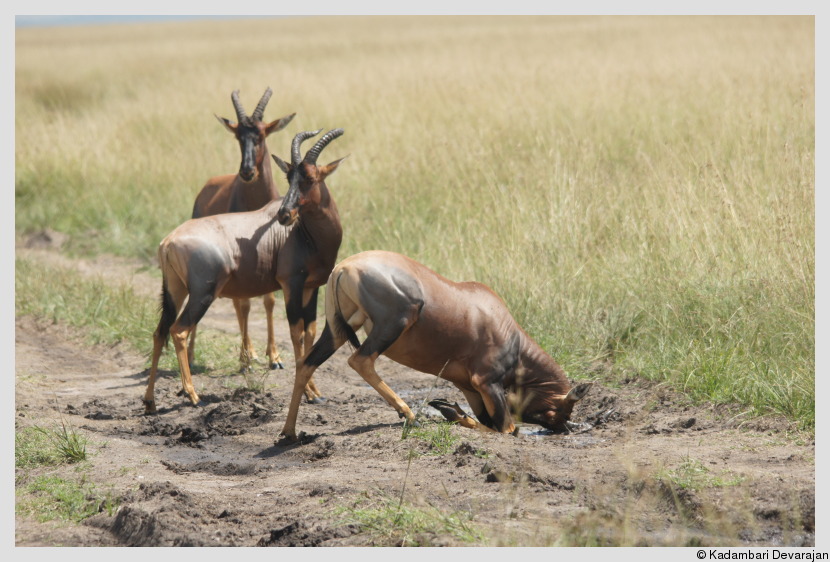
Topi drinking from a small pool
The lion section in my big cat diary has a montage of a pride of lions hunting down a topi.

Topi
Large herds of topi typically travel with the wildebeest, gazelles and other herbivores in their migration from the Serengeti. They are either numerous or absent in a given area, and patchy distributions are usually unsuccessful. They either increase in number when scattered or die off.
White-bearded wildebeest (Connochaetes taurinus)
Wildebeest are also popularly known as gnu. They are horse antelopes, even-toed ungulates that are numerous and widely distributed across sub-Saharan Africa. They usually commence the great migration and millions of wildebeest migrate from Serengity to the Masai Mara during the dry season starting in every July, searching for greener pastures. They are accompanied by gazelles and other herbivores, and followed by predators.
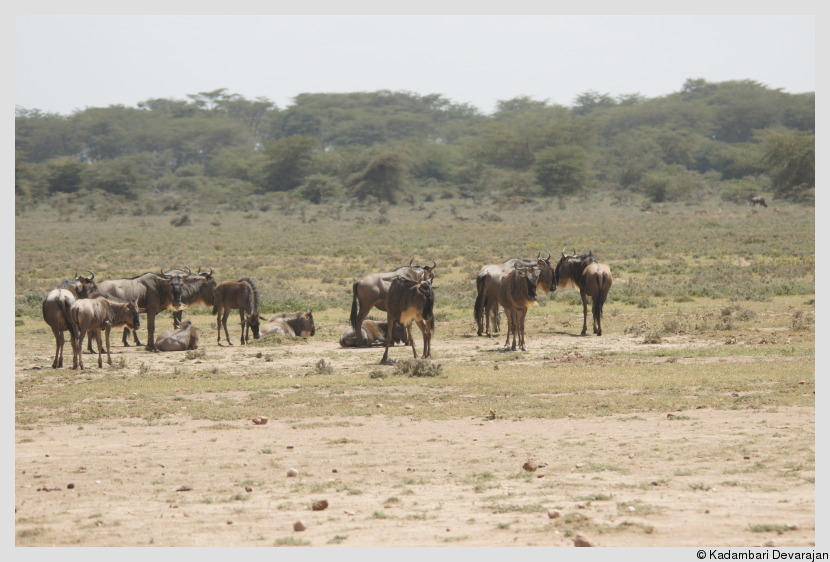
White-bearded wildebeest
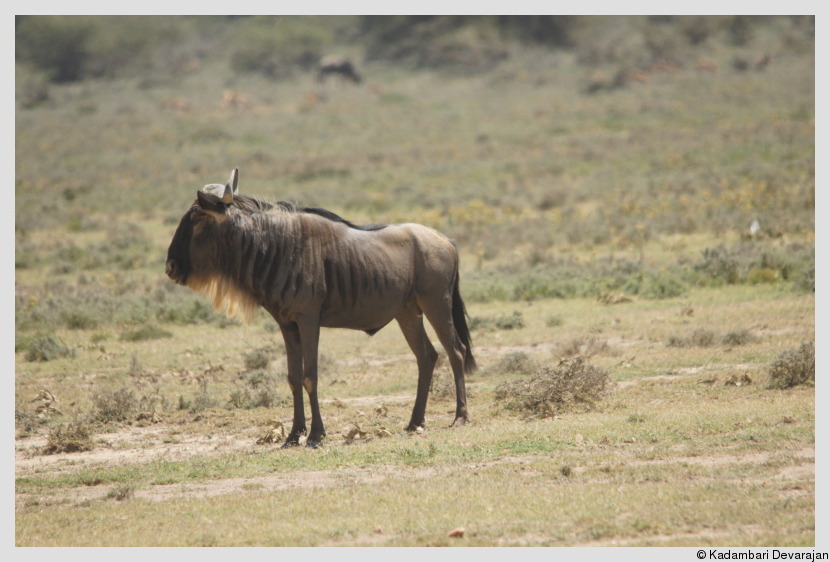
White-bearded wildebeest
Reedbucks and kobs
Two species of reedbucks and kobs can be found in the Mara. These are the common reedbuck (Redunca arundinum) and the Defassa waterbuck (Kobus ellipsiprymnus defassa). Neither are very common or numerous in the park.
Defassa waterbuck (Kobus ellipsiprymnus defassa)
The waterbuck is a large antelope that is widely distributed across sub-Saharan Africa. They are not social, are typically solitary or in small groups, and not very numerous. We managed to see waterbuck twice during our visit to the mara. It is called the greasy kob after the greasy secretion from the waterbuck when sexually excited. The term waterbuck is somewhat a misnomer, since they do not spend too much time in water, and prefer scrub forests and savannas. They however seem to prefer areas near water bodies.
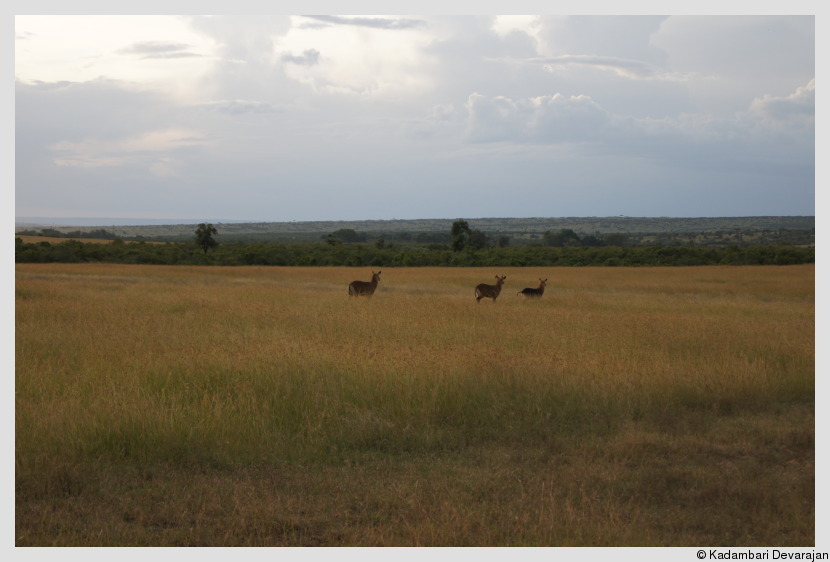
Defassa waterbuck
Dwarf antelopes
There are three species of dwarf antelopes that can be found in the Mara. These are the Kirk's dikdik (Madoqua kirkii), oribi (Ourebia ourebi), and klipspringer (Oreotragus oreotragus). The Kirk's dikdik and klipspringer can be hard to distinguish apart while the oribi look similar to female impala.
Kirk's dikdik (Madoqua kirkii)

Kirk's dikdik
Oribi (Ourebia ourebi)
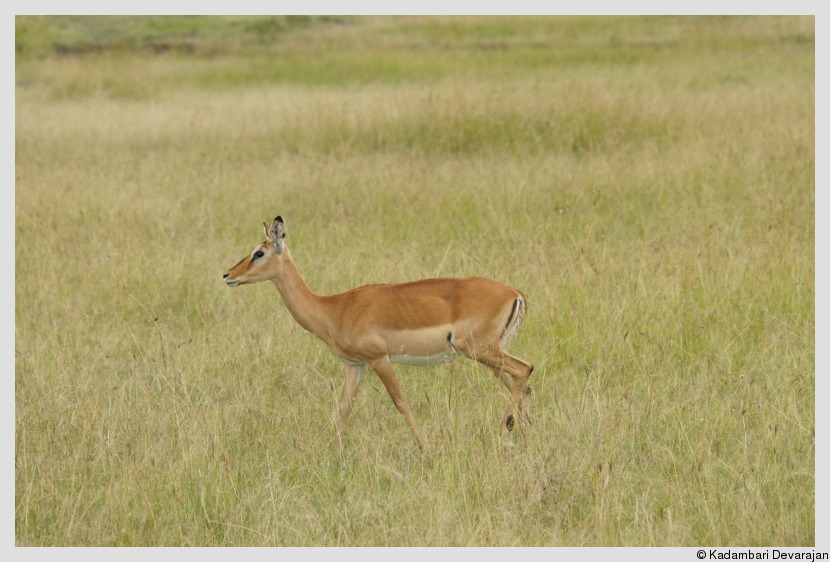
Oribi
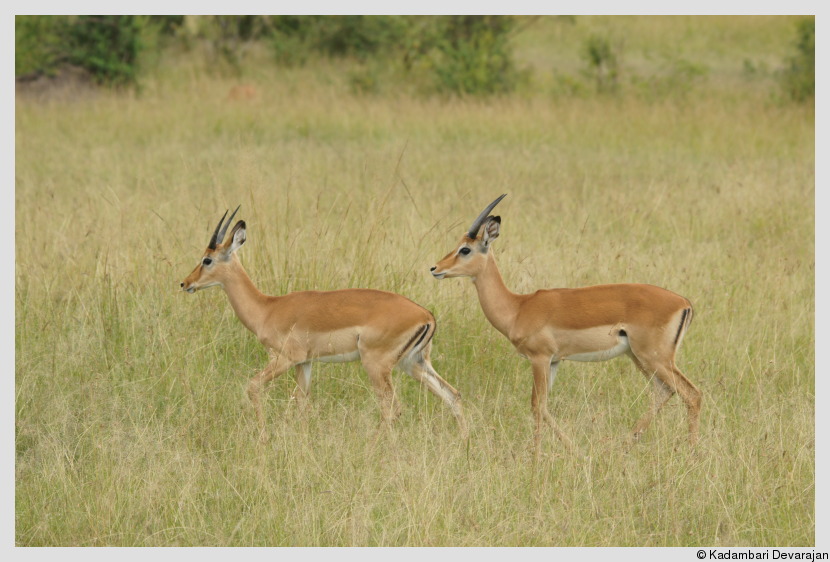
Oribi
Klipspringer (Oreotragus oreotragus)
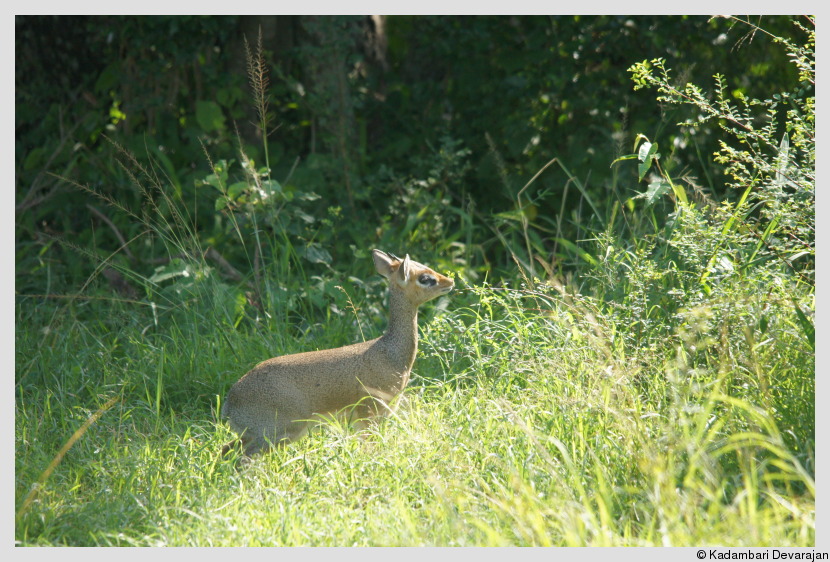
Klipspringer
Gazelles
There are two species of gazelles found in the Masai Mara, namely Grant's gazelle (Gazella granti) and Thomson's gazelle (Gazella thomsonii). Large populations of both exist in the Mara. Huge herds of both gazelles accompany the wildebeest on their migratory route from the Serengeti and back.
Grant's gazelle (Gazella granti)
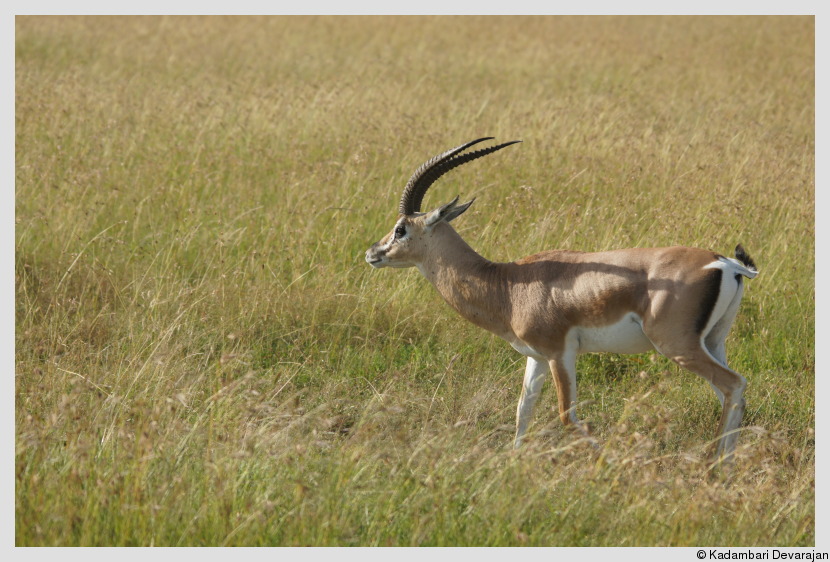
Grant's gazelle in the grassland

Grant's gazelle
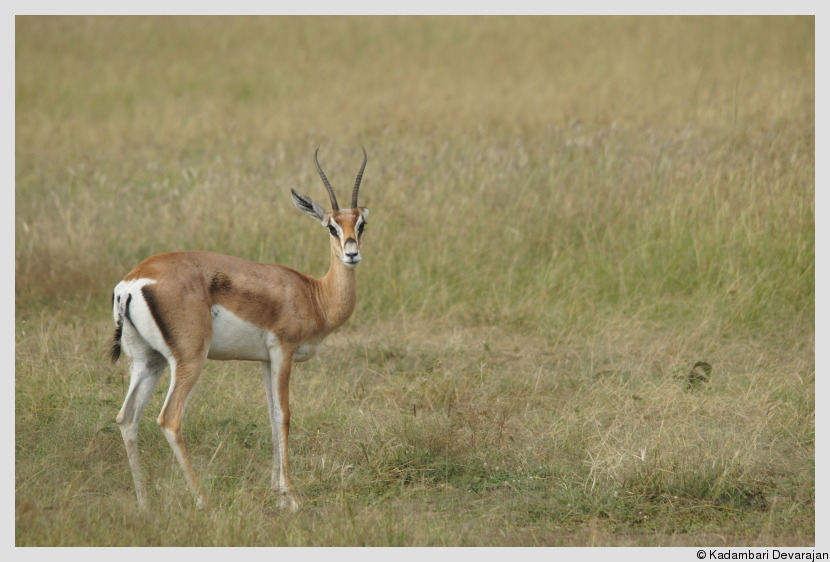
Grant's gazelle
Thomson's gazelle (Gazella thomsonii)
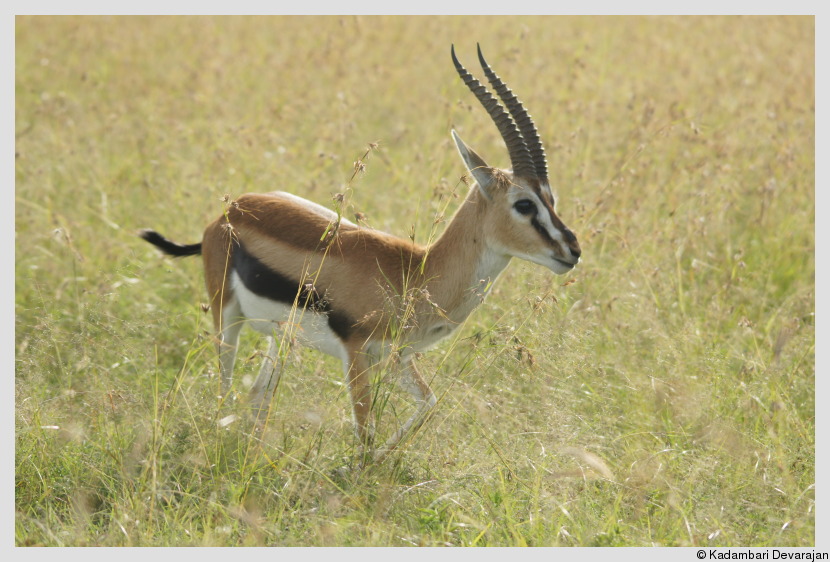
Thomson's gazelle
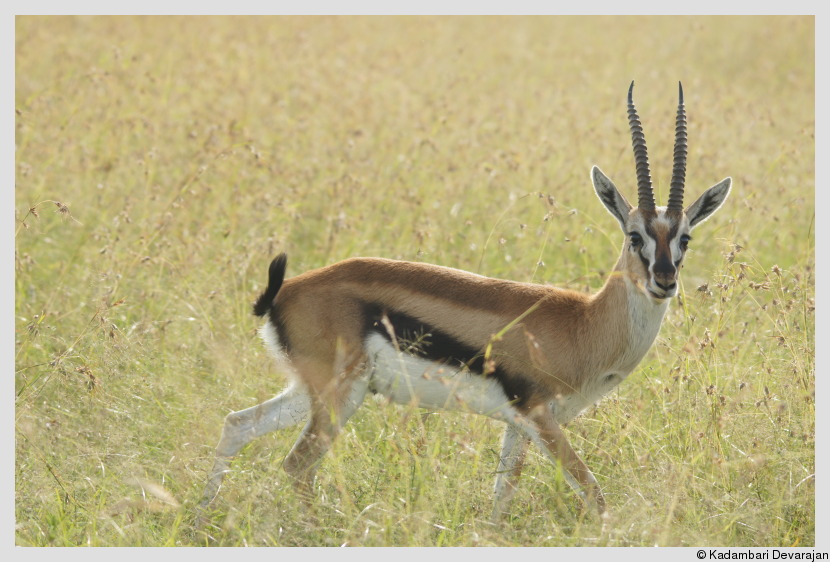
Thomson's gazelle, in the bush
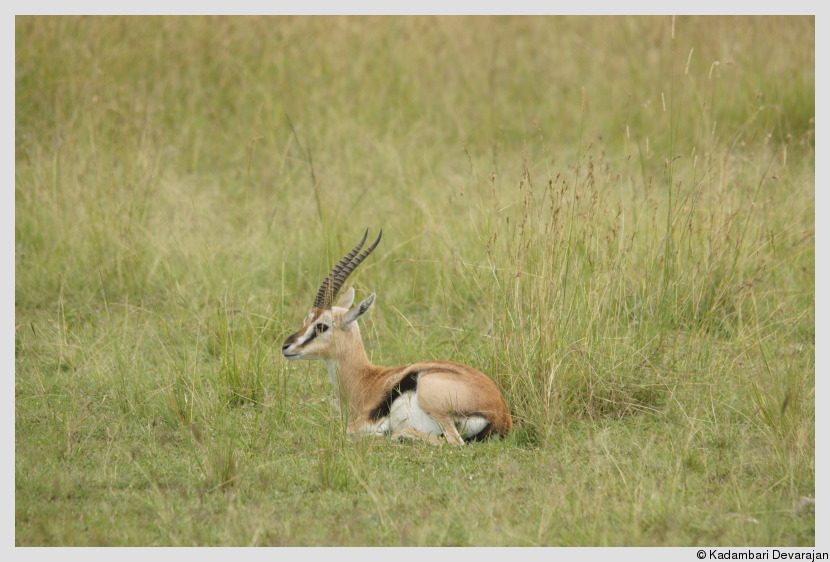
Thomson's gazelle sitting
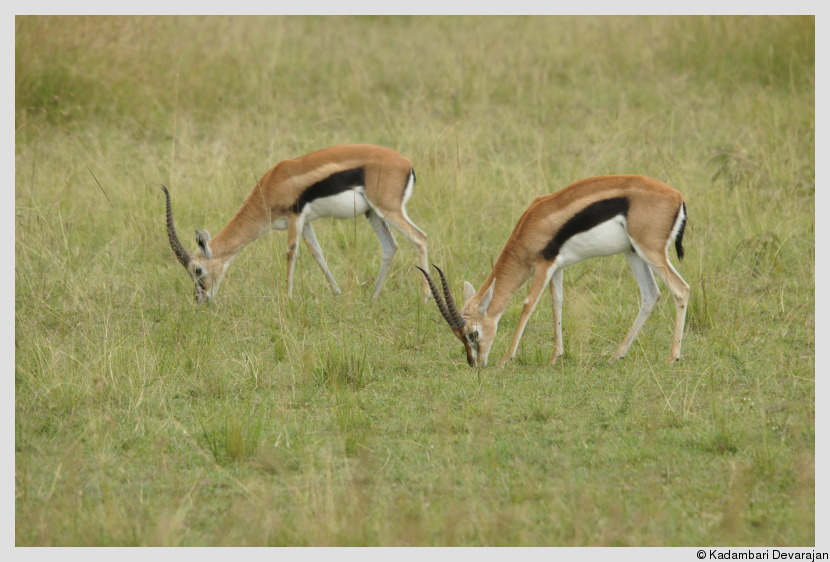
Thomson's gazelle grazing
Impala
Impala (Aepyceros melampus) are medium-sized antelope that are widely distributed across central and east Africa. Large populations can be found throughout Kenya including inside the Masai Mara. Two sub-species of the impala are thought to exist, namely the common impala (A. m. melampus) and the black-faced impala (A. m. petersi).
Impala (Aepyceros melampus)
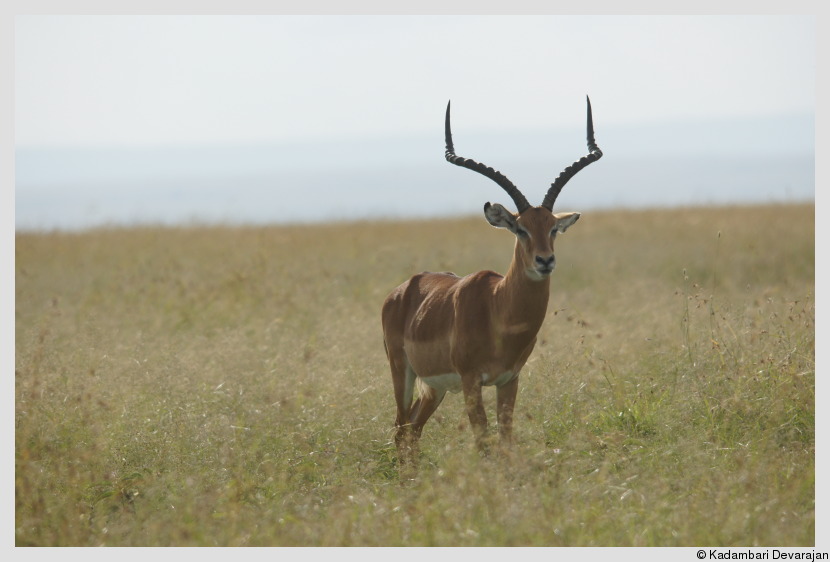
Male impala in the savanna
They are sexually dimorphic with the males sporting long, elegant, spiral horns. They graze as well as browse, and typically switch between grazing and browsing according to the season, habitat and vegetation available.
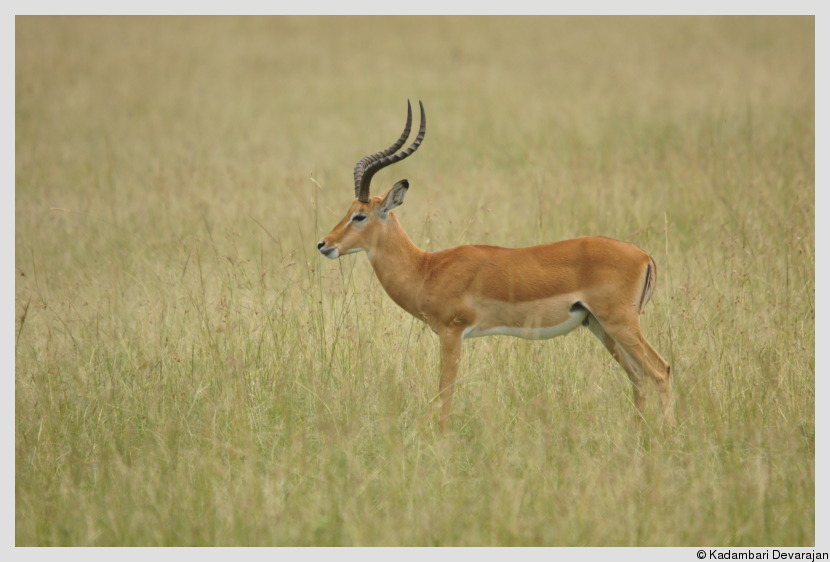
Male impala
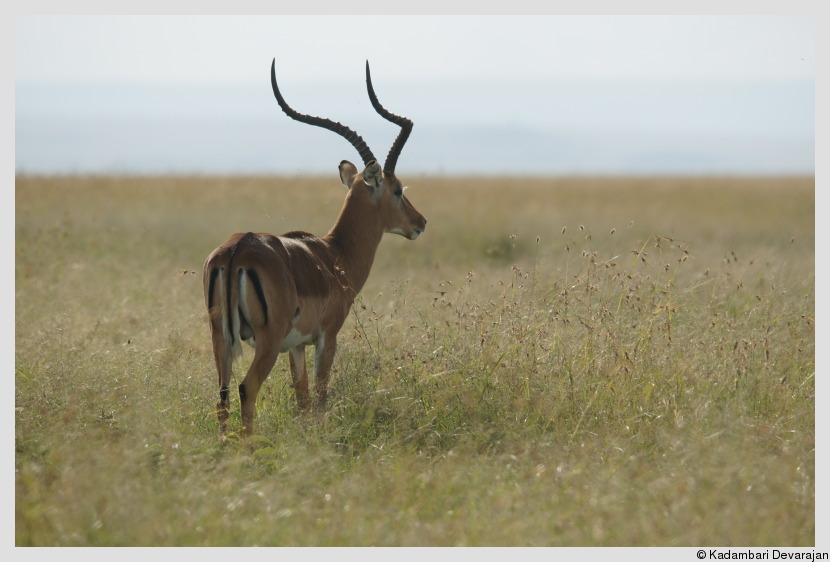
Impala profile
Zebras and asses
Zebras are African equids that are characterized by their distinctive black and white stripes. Their stripes are unique for each individual and act like a 'fingerprint' or 'barcode' for recognizing and identifying individuals. They are social animals that live in harems, with many harems making a herd. There are three species of zebras that are found in Africa and native to it. These are the plains or common zebra (Equus burchellii), the Grevy's zebra (Equus grevyi), and the mountain zebra (Equus zebra). We saw the common zebra in different parts of Kenya including the Mara, and the Grevy's zebra in Laikipia.
Common zebra (Equus burchellii)
The common zebra is also called the plains zebra or Burchell's zebra. It is the most common and geographically widespread of the equids in Africa. The extinct quagga is a sub-species of the common zebra.
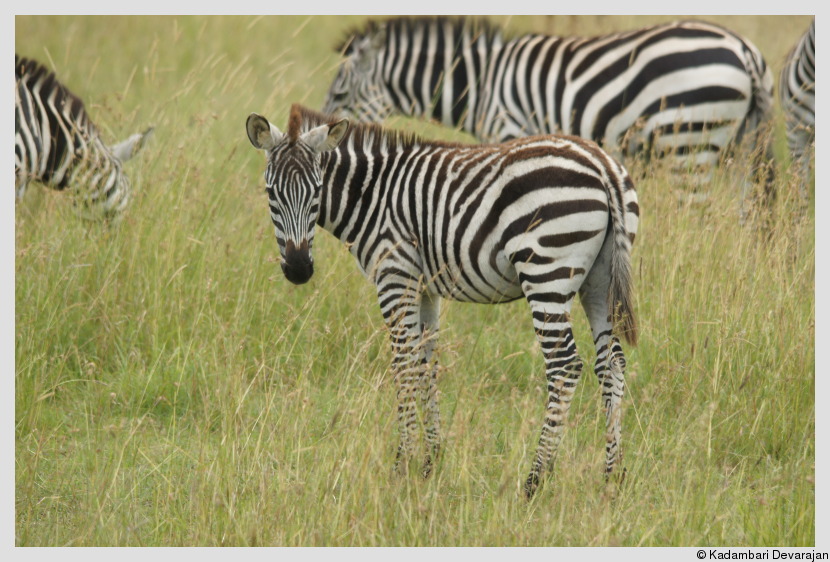
Common zebra
The common zebra is a highly social equid where the social structure typically involves a single stallion and his harem of several mares and their offspring.

Common zebra
Monkeys and baboons
There are four species of monkeys and baboons found in the Masai Mara. These include the olive baboon (Papio cynocephalus anubis), vervet monkey (Cercopithecus aethiops), Syke's monkey (Cercopithecus mitis), and copper-tailed monkey (Cercopithecus ascanius). Of these, we managed to see the olive baboon inside the Mara, the Syke's monkey at a Rift Valley viewpoint on our way from Nairobi to the Mara, and the vervet monkey at Laikipia.
Olive baboon (Papio cynocephalus anubis)

Olive baboon
Syke's monkey (Cercopithecus mitis)
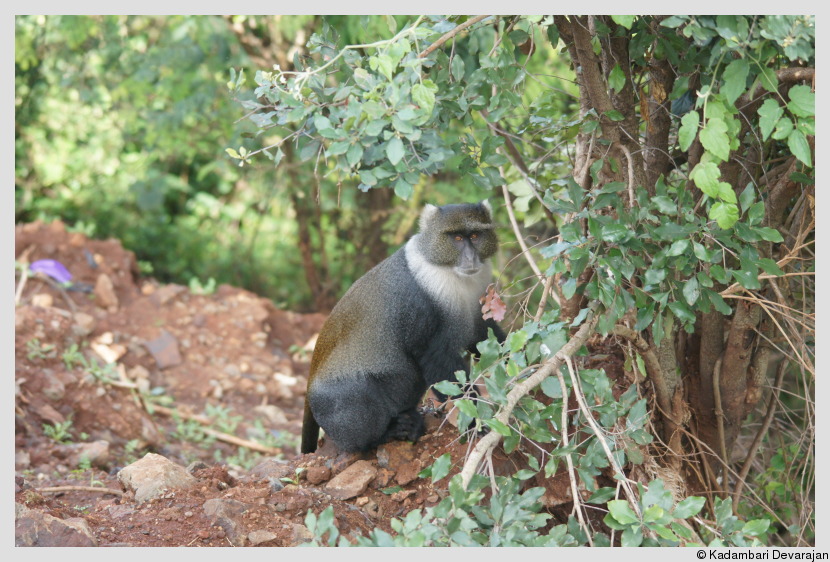
Syke's monkey
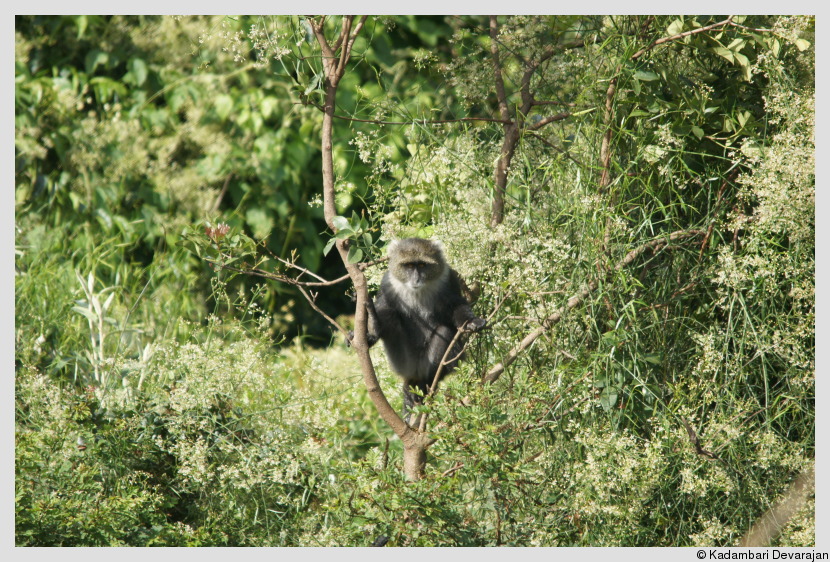
Syke's monkey
Mammal list:
The complete list of mammals found in the Mara can be found here.
The mammals we were able to spot inside the Masai Mara National Reserve are listed below in alphabetical order.
Baboon, Olive
Bat, Straw-colored Fruit
Bat, Yellow-winged
Buffalo, African
Bushbuck
Cheetah
Dikdik, Kirk's
Elephant, African
Gazelle, Grant's
Gazelle, Thomson's
Giraffe, Masai
Hartebeest, Coke's
Hippopotamus, Common
Hyena, Spotted
Impala
Jackal, Black-backed
Klipspringer
Lion, African
Mongoose, Banded
Monkey, Syke's
Monkey, Vervet
Oribi
Squirrel, Kenyan Tree
Topi
Warthog
Waterbuck, Defassa
Wildebeest, White-bearded
Zebra, Common
Total - 28
Birds
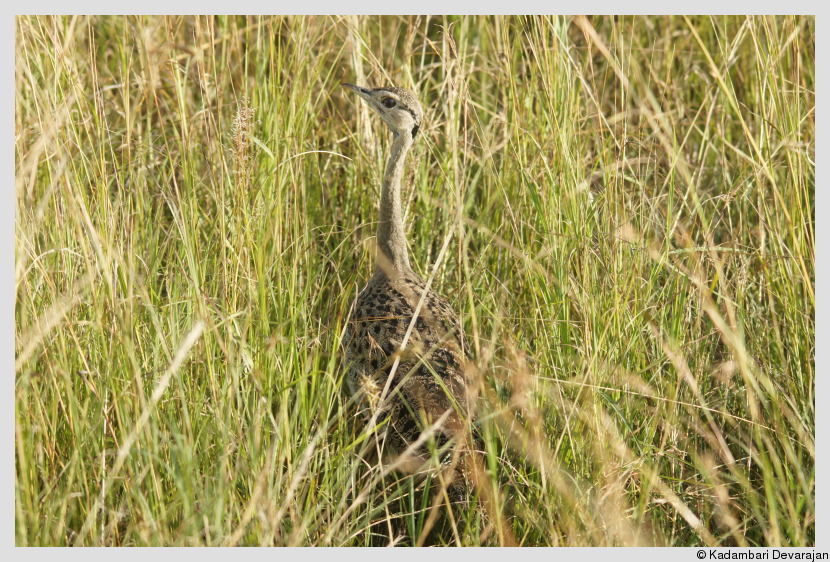
Black-bellied bustard

Beautiful sunbird
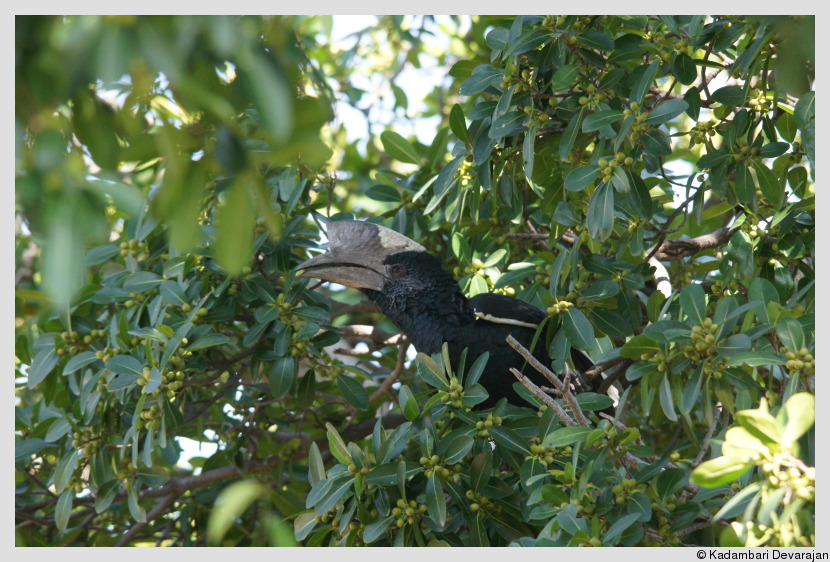
Black-and-white casqued hornbill

Cinnamon-chested bee-eater

Coqui francolin
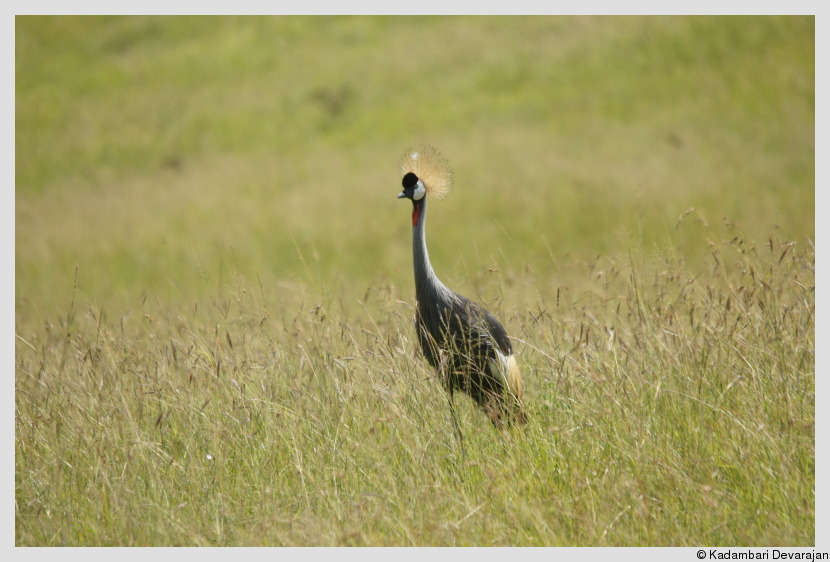
Crowned crane
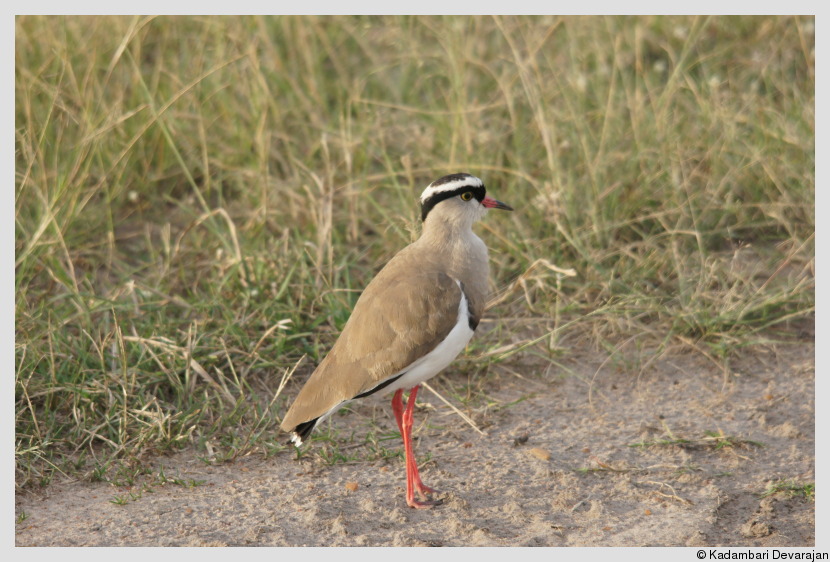
Crowned lapwing
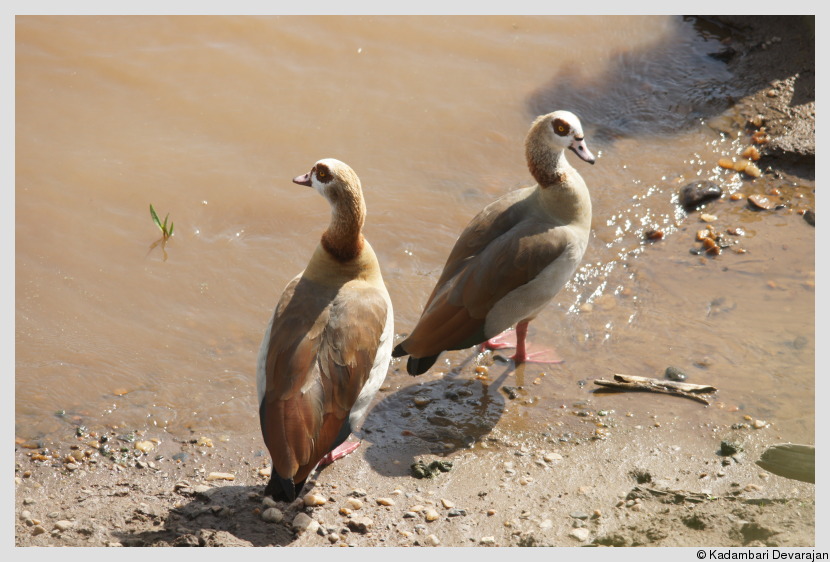
Egyptian geese
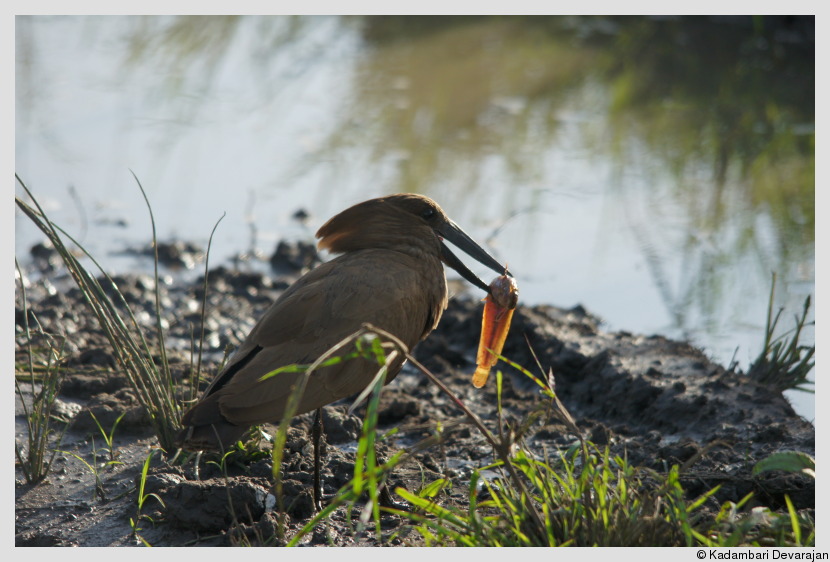
Hamerkop
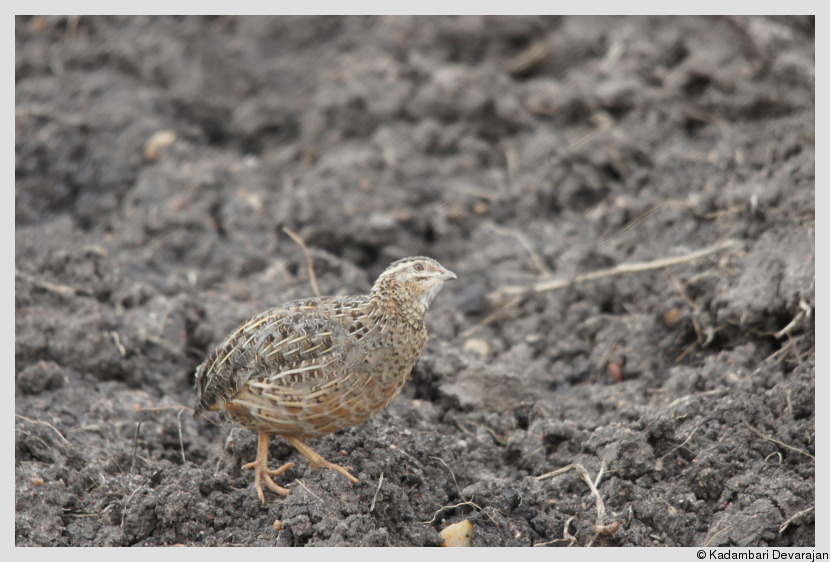
Harlequin quail (female)
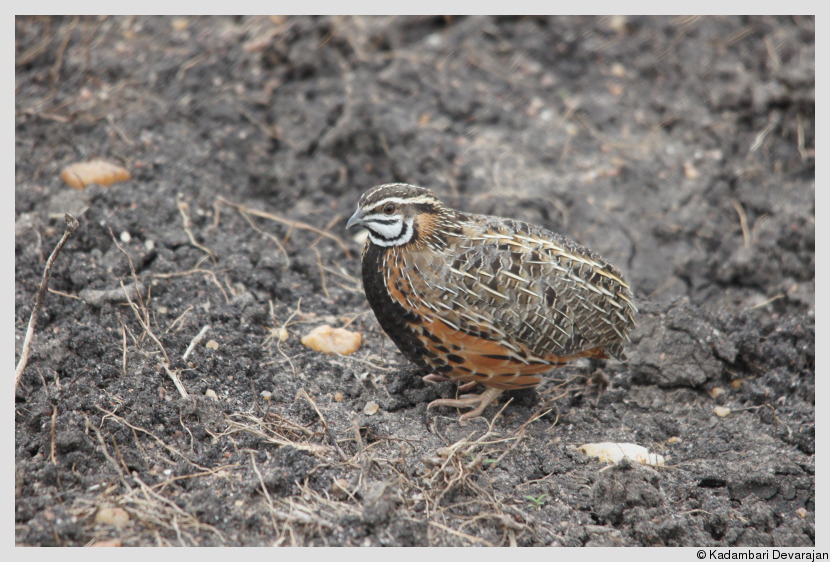
Harlequin quail (male)

Helmeted guineafowl
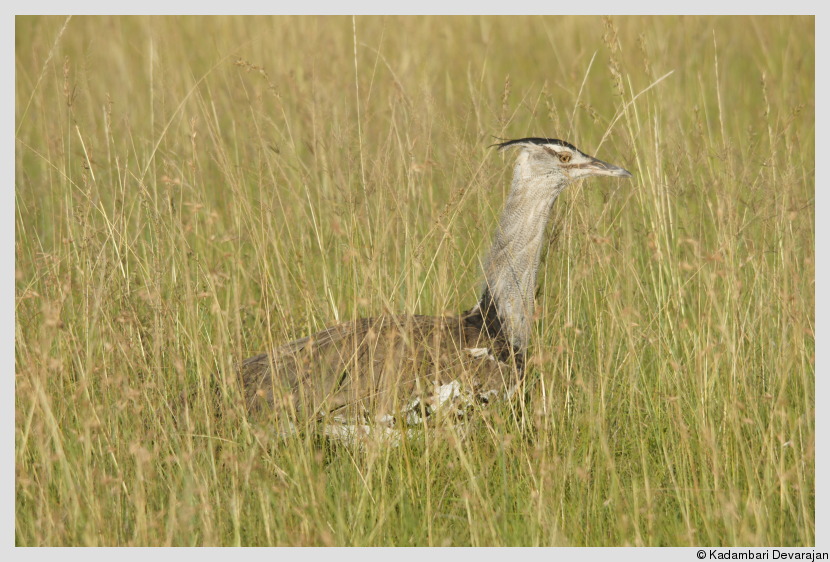
Kori bustard
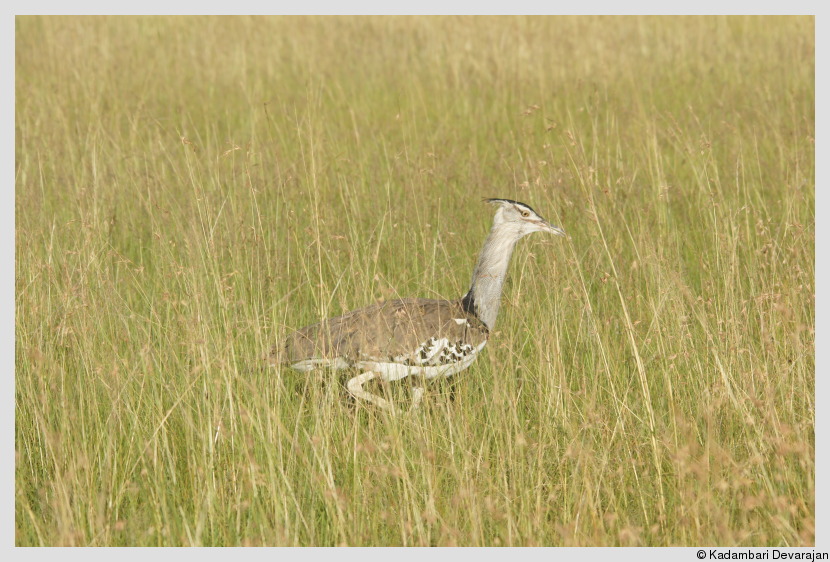
Kori bustard
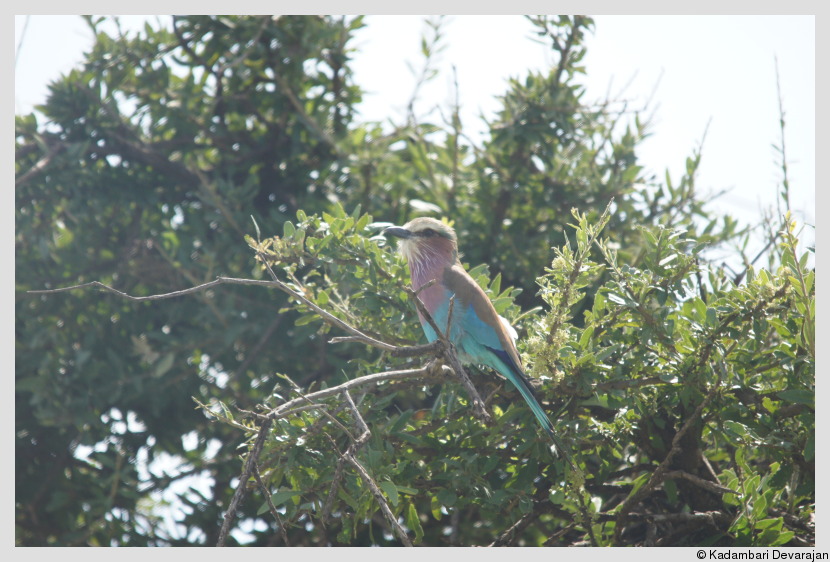
Lilac-breasted roller - the national bird of Kenya
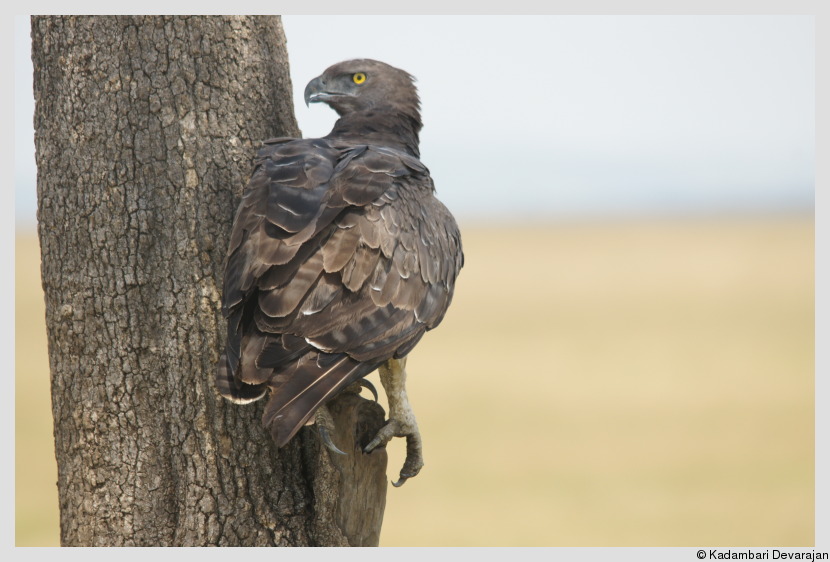
Martial eagle
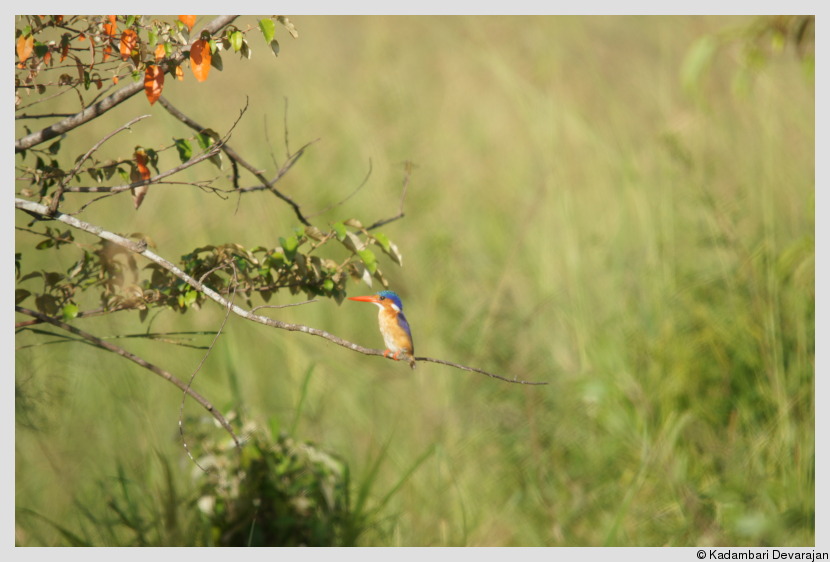
Malachite kingfisher
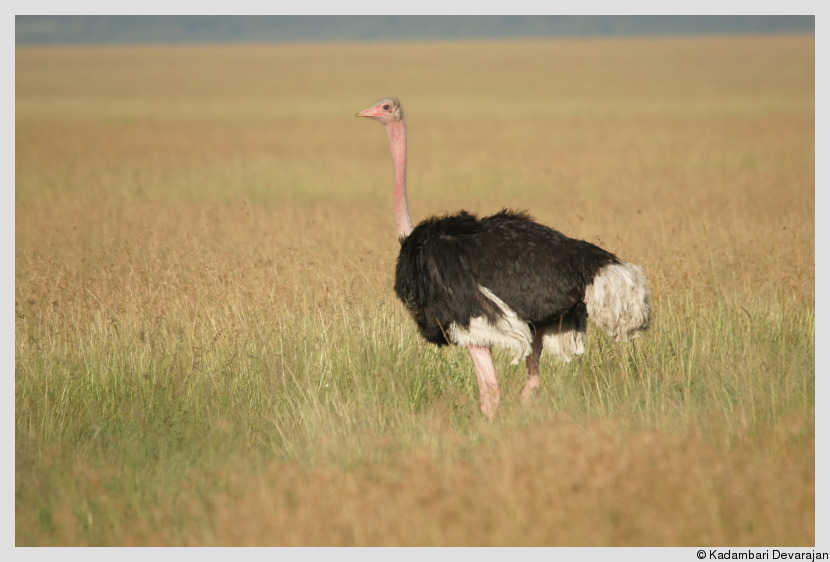
Masai ostrich (male)

Masai ostrich (female)
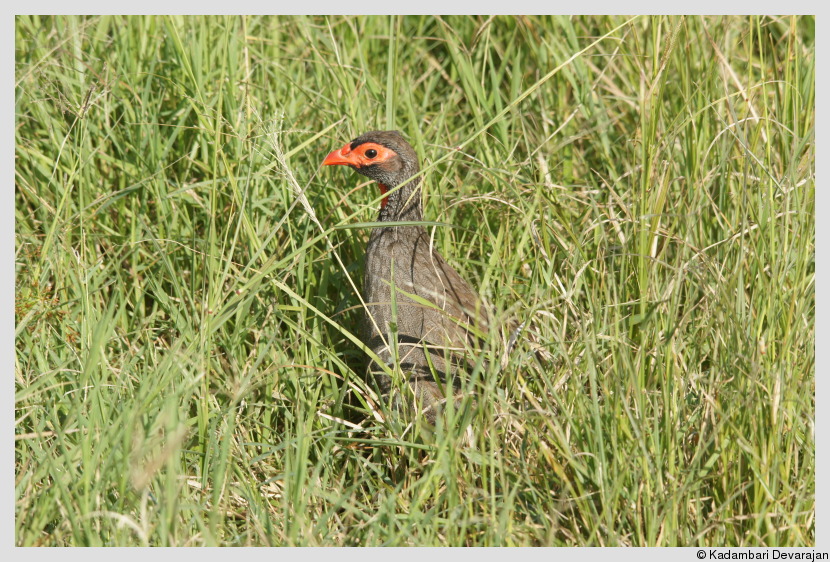
Red-necked spurfowl (male)
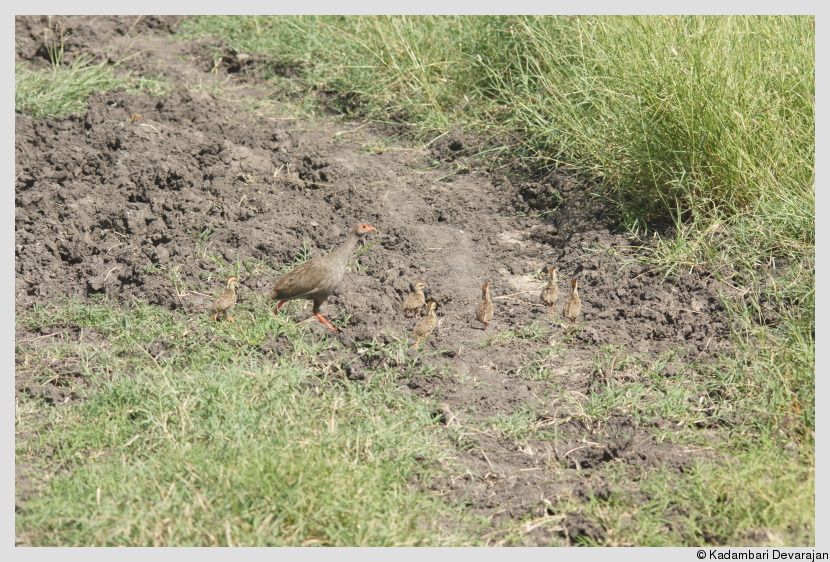
Red-necked spurfowl (female with chicks)
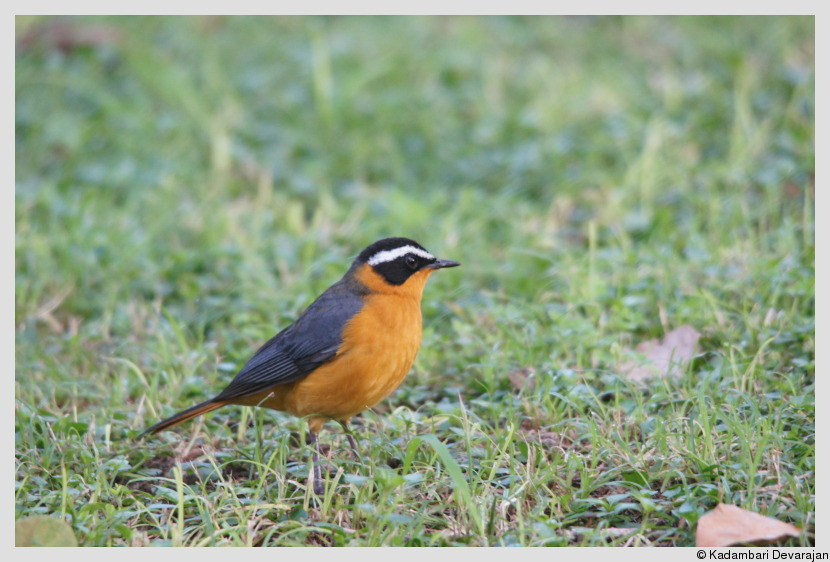
Ruppell's robin chat

Secretary bird
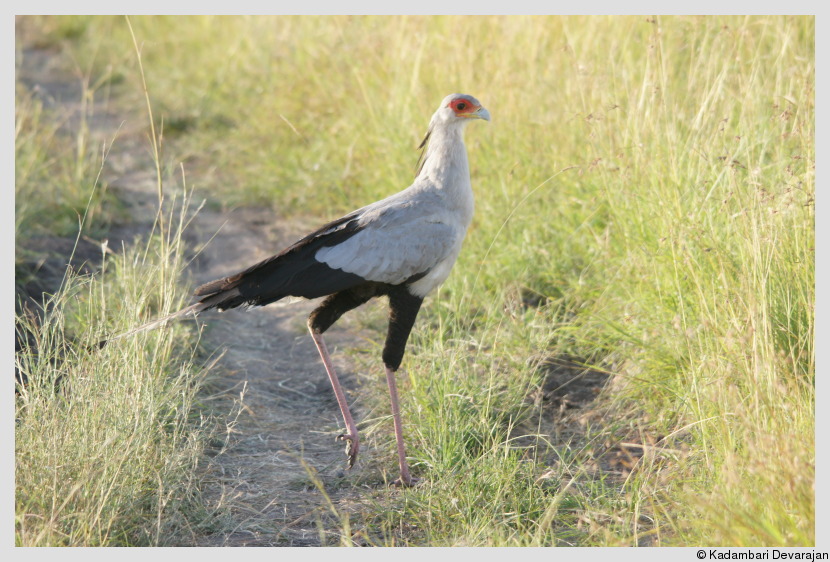
Secretary bird
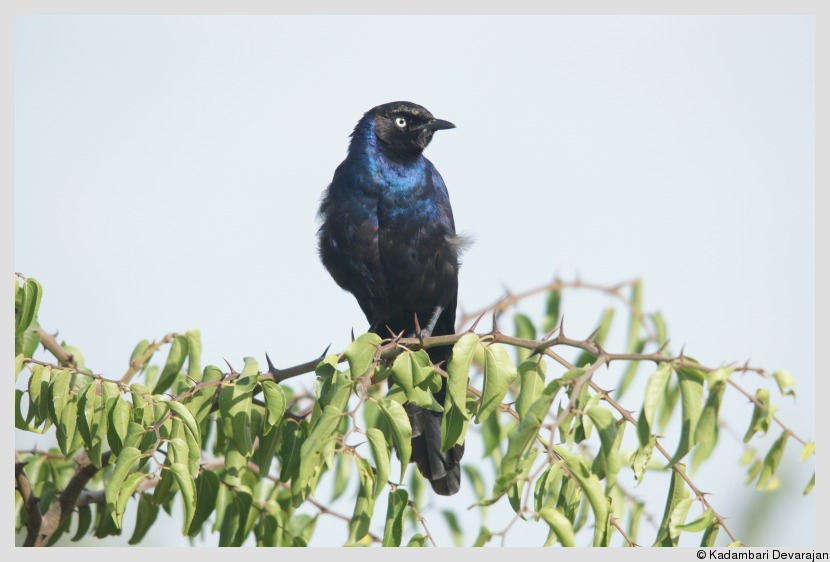
Splendid starling

Spur-winged plover
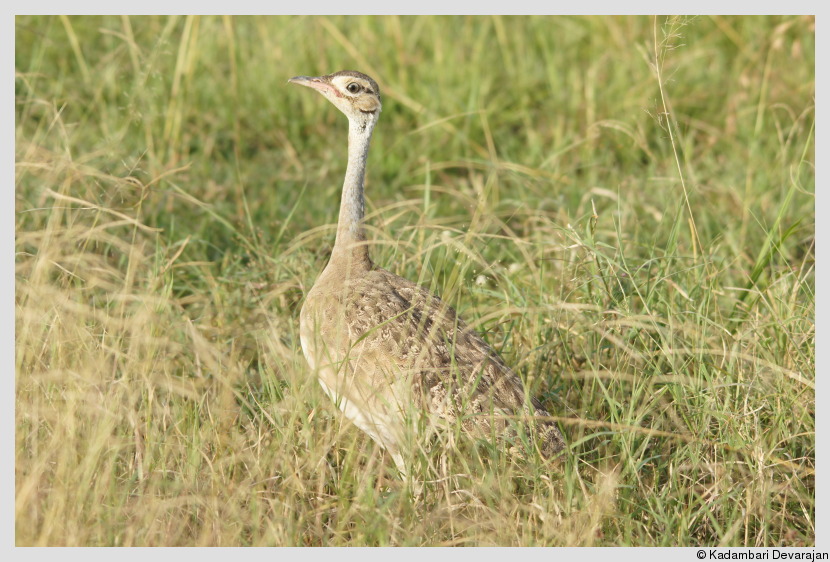
White-bellied bustard (female)
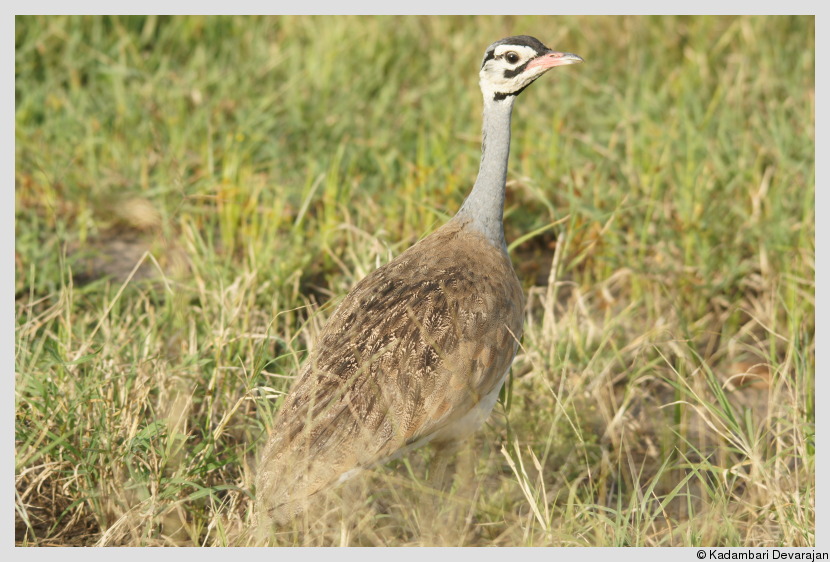
White-bellied bustard (male)
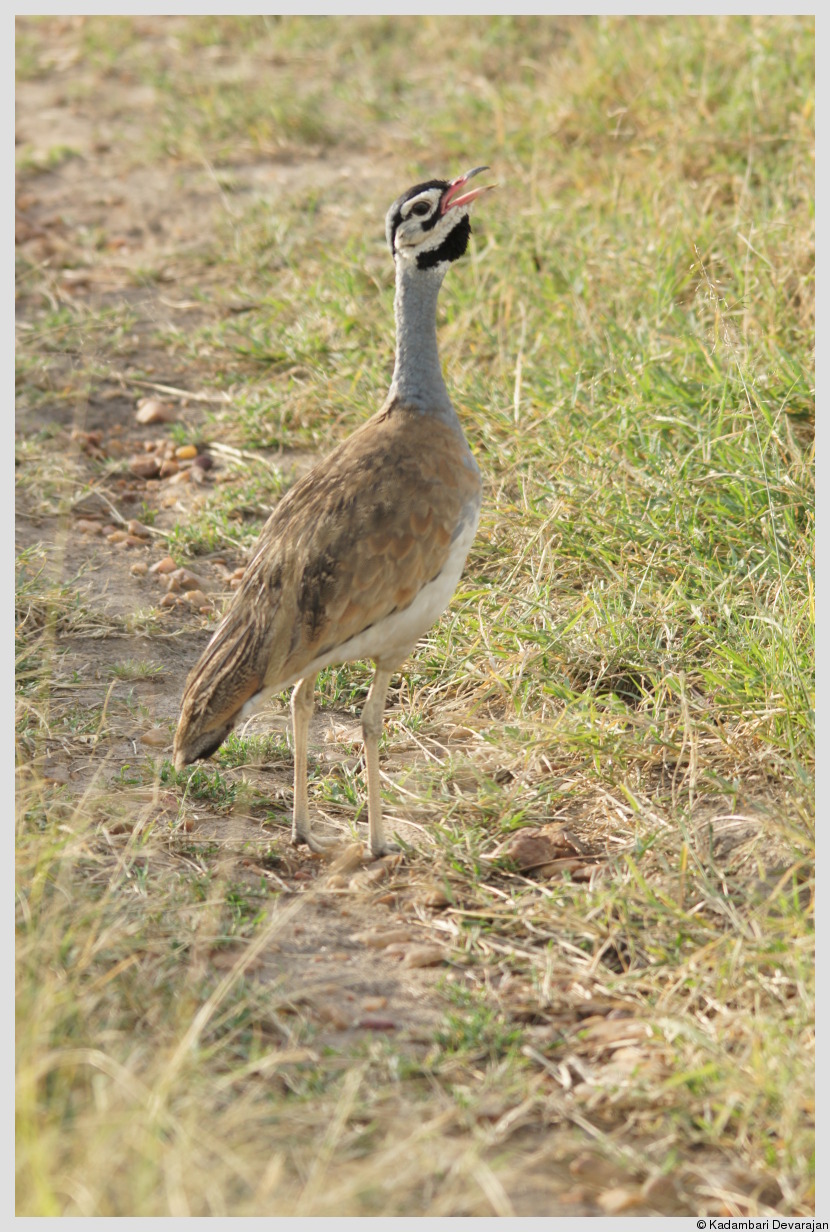
White-bellied bustard (male, calling)
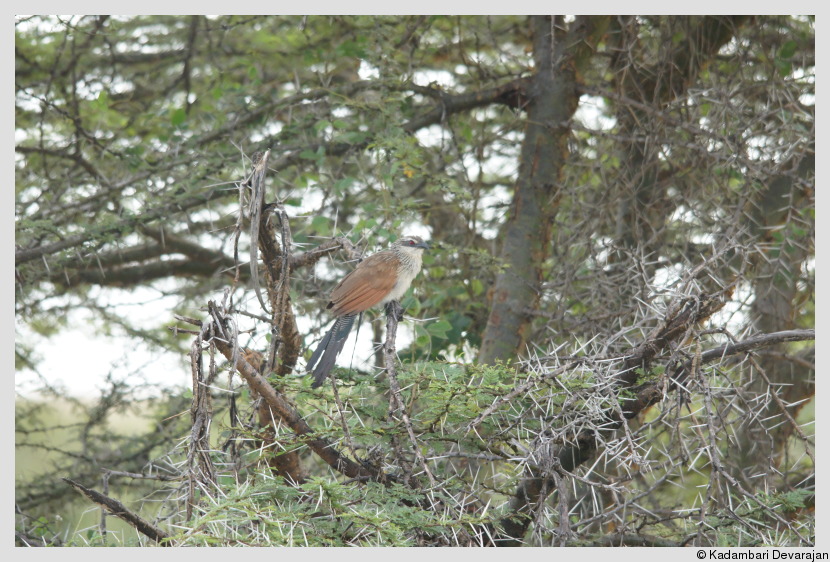
White-browed coucal
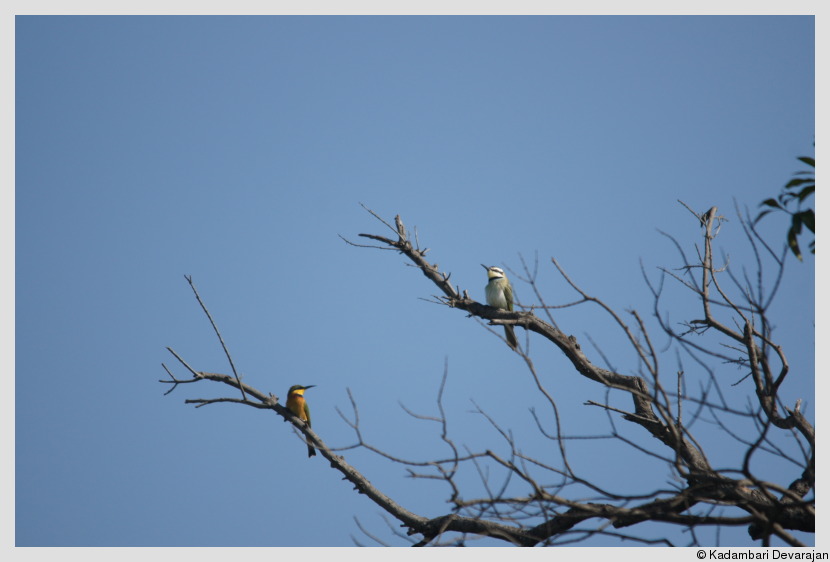
White-throated bee-eater (above) and cinnamon-chested bee-eater (below)
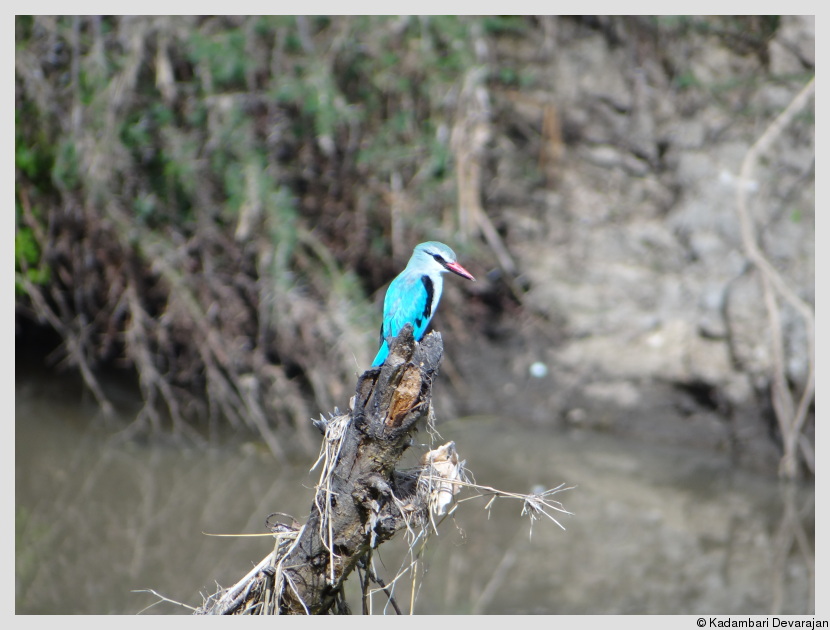
Woodland kingfisher
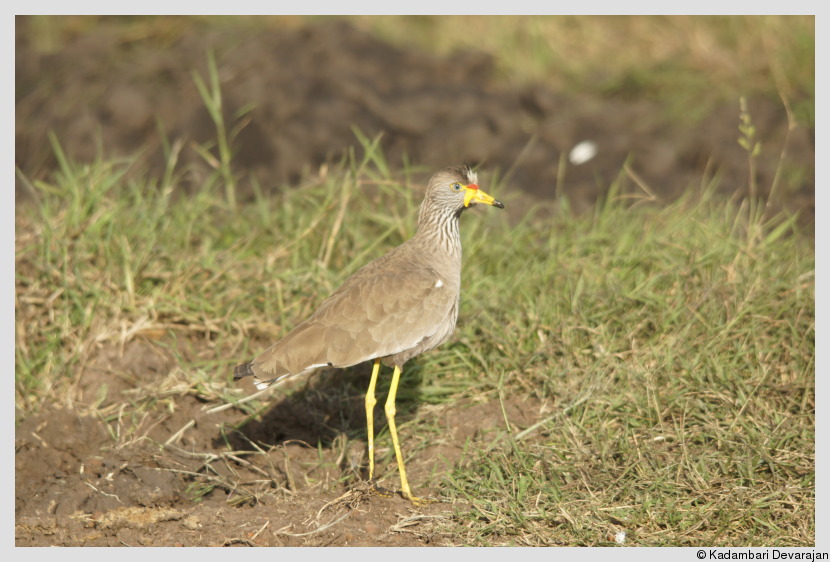
Yellow-wattled plover
Birds:
Barbet, Red-fronted
Bee-eater, Cinnamon-chested
Bee-eater, White-throated
Bird, Secretary
Bishop, Yellow
Bulbul, Common
Bustard, Black-bellied
Bustard, Kori
Bustard, White-bellied
Buzzard, Augur
Chat, Anteater
Chat, Northern Anteater
Chat, Sooty
Cisticola, Calling
Cisticola, Singing
Cisticola, Wattling
Coucal, ?
Coucal, White-browed
Cranes, Grey Crowned
Crow, Pied
Dove, African Mourning
Dove, Collared
Dove, Emerald Spotted Dove
Dove, Laughing
Dove, Ring-necked
Eagle, Batelur
Eagle, Black-chested Snake
Eagle, Brown Snake
Eagle, Martial
Eagle, Tawny
Eagle, Batelur
Egret, Black
Egret, Cattle
Flycatcher, African Paradise
Flycatcher, White-eyed Slaty
Francolin, Coqui
Francolin, Jackson's
Geese, Egyptian
Goaway Bird, Bare-faced
Goaway Bird, White-bellied
Goose, African Pygmy
Griffon, Ruppell's
Guineafowl, Helmeted
Hamerkop
Heron, Grey
Hornbill, Black-and-white Casqued
Hornbill, Southern Ground
Ibis, Glossy
Ibis, Sacred
Kingfisher, Malachite
Kingfisher, Pied
Kingfisher, Pygmy
Kingfisher, Woodland
Kite, Black
Lapwing, Crowned
Lapwing, Long-toed
Lark, Rufous-necked
Longclaw, Yellow-throated
Mousebird, ?
Mousebird, Blue-naped
Mousebird, Speckled
Oriole, African Black-headed
Ostrich, Masai
Pigeon, African Green
Pigeon, Olive
Pigeon, Speckled
Pipit, Grassland
Pipit, Long-billed
Plover, Golden
Plover, Spur-winged
Plover, Three-banded
Plover, Yellow-wattled
Quail, Common Button
Quail, Harlequin
Robin Chat, Rupell's
Roller, Lilac-breasted
Roller, Cinnamon-chested
Rook, Cape
Sandgrouse, Four-banded
Shrike, Black-headed
Shrike, Common Fiscal
Shrike, Grey-backed Fiscal
Shrike, Long-tailed Fiscal
Sparrow, House
Sparrow, Rufous
Spurfowl, Red-necked
Starling, Hildebrandt's
Starling, Superb
Starling, Purple
Starling, Slender-billed
Starling, Splendid
Stork, Yellow-billed
Stork, Marabou
Stork, Saddle-billed
Sunbird, Beautiful
Swallow, Rufous-chested
Swallow, Wire-tailed
Swift, ? Large
Thrush, Olive
Tinkerbird, Red-fronted
Vulture, African White-backed
Vulture, Black-backed
Vulture, Hooded
Vulture, Lappet-faced
Vulture, White-backed
Vulture, White-headed
Wagtail, White
Wagtail, African Pied
Warbler, ?
Weaver, Golden
Weaver, Red-headed
Weaver, White-headed Buffalo
Widow Bird, Fan-tailed
Wydah, Pin-tailed
Total - 114
PS - My partner and I went on a holiday to Kenya (to celebrate my admission into the wildlife biology program at NCBS) in 2012. This is the first trip report from that trip. We saw more than 40 species of mammals, more than 250 species of birds, and a few odd reptiles over a two week trip.